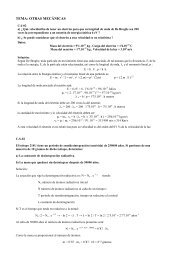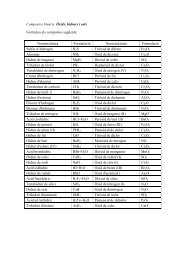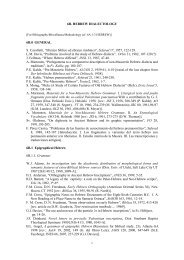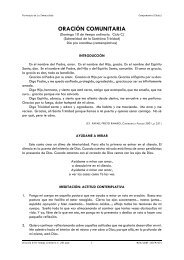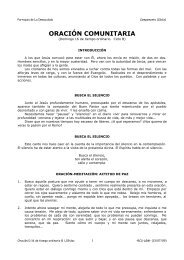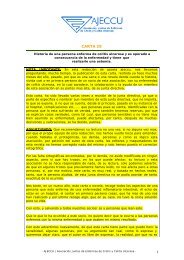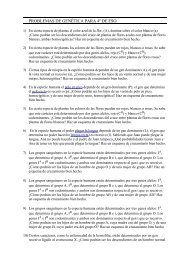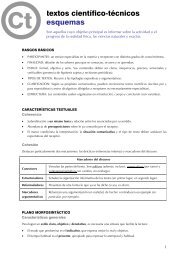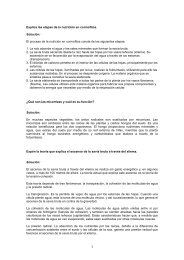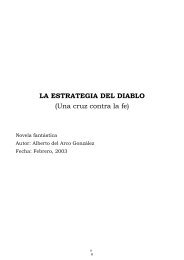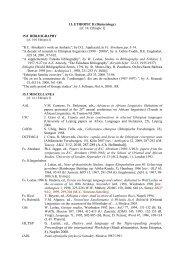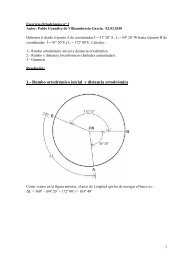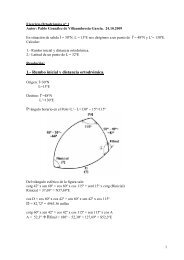“Bibliografia [di studi fenici]”, by E. Acquaro: 1 - Telefonica.net
“Bibliografia [di studi fenici]”, by E. Acquaro: 1 - Telefonica.net
“Bibliografia [di studi fenici]”, by E. Acquaro: 1 - Telefonica.net
Create successful ePaper yourself
Turn your PDF publications into a flip-book with our unique Google optimized e-Paper software.
7.0 BIBLIOGRAPHY<br />
[cf. 1.0.1; 4.0.1]<br />
7.0.1General<br />
7. PHOEICIA/PUIC<br />
<strong>“Bibliografia</strong> [<strong>di</strong> stu<strong>di</strong> <strong>fenici</strong>]<strong>”</strong>, <strong>by</strong> E. <strong>Acquaro</strong>: 1 (1971-1972), RSF 1, 1973, 111-119; 2 (1973) RSF 2,<br />
1974, 123-135; 3 (1974), RSF 3, 1975, 131-141; 4 (1975), RSF 4, 1976, 117-127; 5 (1976), RSF 5,<br />
1977, 105-116; 6 (1977), RSF 6, 1978, 117-126; 7 (1978), RSF 7, 1979, 131-141; 8 (1979), RSF 8,<br />
1980, 155-164; 9 (1980), RSF 9, 1981, 133-142;. 10 (1981), RSF 10, 1982, 141-151; 11 (1982), RSF<br />
11, 1983, 121-130; 12 (1983), RSF 12, 1984, 111-132; 13 (1984), RSF 13, 1985, 155-178; a cura della<br />
Redazione della RSF: 14 (1985), RSF 14, 1986, 257-274; 15 (1986), RSF 15, 1987, 199-214; 16<br />
(1987), RSF 16, 1988, 269-287; 17 (1988), RSF 17, 1989, 313-344; 18 (1989), RSF 18, 1990, 235-<br />
266; a cura de E. <strong>Acquaro</strong>, F. Mazza, S. Ribichini; P. Xella: 19 (1990), 19, 1991, 243-276; 20 (1991),<br />
RSF 20, 1992, 203-242; 21 (1992), RSF 21, 1993, 251-279; 22 (1993), RSF 22, 1994, 281-306; 23<br />
(1994), RSF 1995, 217-239; 24 (1995), RSF 24, 1996, 199-227; 25 (1996), RSF 25, 1997, 215-245; a<br />
cura <strong>di</strong> F. Mazza, S. Ribichini: 26 (1997), RSF 26, 1998, 247-270; a cura <strong>di</strong> P. Bartoloni, F. Mazza, S.<br />
Ribichini: 27 (1998), RSF 27, 1999, 211-237; 28 (1999), RSF 28, 2000, 217-243; 29 (2000), RSF 29,<br />
2001, 245-287; a cura <strong>di</strong> M. Botto, L. Campanella, F. Mazza, S. Rebichini: 30 (2001), RSF 30, 2002,<br />
237-274; RSF 31, 2003, 177-193.<br />
<strong>“Bibliografia</strong> delle pubblicazioni più recenti sulle scoperte <strong>di</strong> Pyrgi<strong>”</strong>, <strong>by</strong> G. Colonna, M. Cristofani, G.<br />
Garbini, ArchClass 18, 1966, 270-282.<br />
Bibliotheca Phoenicia. Ottomila titoli sulla civiltà <strong>fenici</strong>a, <strong>by</strong> E. <strong>Acquaro</strong> (StFen 35), Roma 1994.<br />
“Chronique d’épigraphie et d’archéologie puniques<strong>”</strong>, <strong>by</strong> J. Février, JA 257, 1969 (1970), 197-202.<br />
“Die Phoenician Language: Remarks on the Present State of Research<strong>”</strong>, <strong>by</strong> W. Röllig, in ACFP 1, pp.<br />
375-85. [184]<br />
“Epigrafia punica nel Magreb, 1979-1980<strong>”</strong>, <strong>by</strong> G. Garbini, StMag 12, 1980, 93-97.<br />
“La questione <strong>fenici</strong>a: venti anni dopo<strong>”</strong>, <strong>by</strong> S. Moscati , in E. Arcaini, S. Cigada, E. Rigotti, eds.,<br />
Diacronia, sincronia e cultura: saggi linguistici in onore <strong>di</strong> Luigi Heilmann (Pubbl. Del centro <strong>di</strong><br />
lingüística de ll’Università Católica, Saggi e Monografie 4), Brescia 1984, pp. 37-44.<br />
“Epigrafia punica nel Magreb (1965-1974)<strong>”</strong>, <strong>by</strong> G. Garbini, StMag 6, 1974, 1-36; “1975-1976<strong>”</strong>, StMag<br />
8, 1976 (1978), 11-24; “1977-1978<strong>”</strong>, StMag 10, 1978, 1-12.<br />
“Epigrafia punica in Sicilia<strong>”</strong>, <strong>by</strong> M.G. Guzzo Amadasi, Kokalos 18-19, 1972-73, 278-289.<br />
“L’epigrafia punica in Sicilia<strong>”</strong>, <strong>by</strong> G. Coacci Polselli, Kokalos 26-27, 1980-1981, 468-478.<br />
“Phoenician<strong>”</strong>, in LBY 1939-..<br />
“Phoenician-Punic<strong>”</strong>, <strong>by</strong> K.R. Veenhof, in BBSSL I, pp. 146-171.<br />
“Phénicien, punique<strong>”</strong>,.in P.-É. Langevin, Bibliographie biblique... I: 1930-1983, Quebec 1985, pp. 432-<br />
438<br />
“Phoenicio-punica<strong>”</strong>, “Phoenicia<strong>”</strong>, in EBB [cf. 4.0].<br />
“Rassegna critica sugli stu<strong>di</strong> <strong>di</strong> lengua <strong>fenici</strong>a<strong>”</strong>, <strong>by</strong> F. Israel, in A7GSCSI, pp. 95-98.<br />
“1979: un bilancio per g!i stu<strong>di</strong> <strong>fenici</strong><strong>”</strong>, <strong>by</strong> G.Garbini, RSF I4, 1986,117-128.<br />
7.0.2 Miscellanea<br />
[cf. 0.2. 0.3]<br />
AC L’Antiquité Classique, Bruxelles.<br />
AcOr Acta Orientalia, Copenhagen.<br />
ACILR 14/1 A. Vàrvaro, ed., XIV Congresso Internazionale <strong>di</strong> Liguistica e Filologia<br />
Romanza, apoli, 15-20 aprile 1974. Atti I, Napoli/Amsterdam 1978.<br />
ACLPI 1 F. Jordá, J. de Hoz, L. Michelena, eds., Actas del I Coloquio sobre lenguas y
culturas prerromanas de la Península Ibérica, I (Acta Salamanticensia, Filosofía<br />
y Letras, 95), Salamanca 1976.<br />
A1CIStFP P. Bartolini et al. eds., Atti del I Congresso internazionale <strong>di</strong> Stu<strong>di</strong> Fenici e<br />
Punici, Roma, 5-10 ovembre 1979. Vol. I; II; III, Roma 1983. [AIO 45/2,<br />
1985, 346-354 (F. Vattioni)].<br />
A2CIStFP E.<strong>Acquaro</strong>, ed., Atti del II congresso internationale <strong>di</strong> stu<strong>di</strong> <strong>fenici</strong> e punici:<br />
Roma. 9-14 ovembre 1987, vols. I-III, Roma 1991.<br />
A7CIHAAN S. Lancel, ed., Afrique du ord antique et mé<strong>di</strong>evale. umismatique, langues,<br />
écritures et arts du livre, spécificité des arts figurés (Actes du VIIe coll. int. sur<br />
l’Histoire et l'Archéologie de l'Afrique du Nord), Paris 1999.<br />
AF Anuari de Filologia, Barcelona.<br />
AJPh American Journal of Philology, Baltimore.<br />
AnnIPhHO Annuaire de l’Institut de Philologie et d’Histoire orientales et slaves, Bruxelles.<br />
AnatS Anatolian Stu<strong>di</strong>es, London<br />
ArchClass Archeologia Classica, Roma.<br />
AuÜ Afrika und Übersee. Sprachen, Kulture, Berlin.<br />
BibOr Bibbia e Oriente, Milano.<br />
CaByr Cahiers de Byrsa , Paris.<br />
CCC G. del Olmo Lete, El continuum cultural cananeo. Pervivencias cananeas en el<br />
mundo <strong>fenici</strong>o-púnico (AuOrSup 14), Sabadell (Barcelona) 1996.<br />
CPhP V. Krings, ed., La civilisation phénicienne et punique (HdO I/20), Leiden 1995.<br />
DCPhP E. Lipiński, ed., Dictionnaire de la Civilisation Phénicienne et Punique,<br />
Turnhout 1992.<br />
FPI G. del Olmo Lete; M.E. Aubet Semmler, eds., Los Fenicios en la Península<br />
Iberica,Vol.1:Arqueología, cerámica y plástica. II:Epigrafia y lengua, glíptica<br />
y numismática, expansión e interacción cultural, Sabadell (Barcelona) 1986.<br />
Fs. Dupont Sommer A.Caquot. M. Philonenko, eds., Hommages à André Dupont-Sommer, Paris<br />
1971.<br />
Fs. Eissfeldt 1947 J. Fück, ed., Festschrift Otto Eissfeldt zum 60. Geburtstage 1.September 1947<br />
dargebracht von Freunden udn Verehrern, Halle an der Saale 1947.<br />
Fs. Eissfeldt 1961 J. Hempel, L. Rost, Hrgs., Von Ugarit nach Qumran. Beiträge zur alttestament-<br />
lichen und altorientalischen Forschung. Otto Eissfeldt zum 1. September 1957<br />
dargebracht von Freuden und Schülern (BZAW 77), Berlin 1961, Verlag A.<br />
Töpelmann.<br />
Fs. Fensham W. Claassen, ed., Text and Context: Old Testament and Semitic Stu<strong>di</strong>es,<br />
Sheffield 1988.<br />
Fs. Friedrich R. Kienle, A. Moorgat, H.Otten, E. von Schuler, W. Zaumseil, eds., Festschrift<br />
Johannes Friedrich zum 65. Geburtstag am 27. August 1958 gewidmet,<br />
Heidelberg 1959.<br />
Fs. Gonin D.M. Kriel, ed., Pro Munere Grates. Stu<strong>di</strong>es presented to H.L. Gonin, Pretoria<br />
1971.<br />
Fs. Lewicki L. Górska, B. Ostafin, eds., Stu<strong>di</strong>a Orientalia Thaddaeo Lewicki oblata:<br />
Conference in honor of Tadeusz Lewicki (1906-1992) held in Kraków on 17-18<br />
ovember 1993, Kraków 1994 [rev.: FO 31, 1995, 243-244 (M. Pomorska)].<br />
Fs. Renard J. Bibaw, ed., Hommages à Marcel Renard, I-III (Coll. Latomus 101-103),<br />
Bruxelles 1969.<br />
Fs. Sznycer Hommages à Maurice Sznycer, I-II (Semitica 38-39), Paris 1990.<br />
JANES Journal of the Ancient ear Eastern Society of Columbia University, New York.<br />
JbKAF Jahrbuch für kleinasiatische Forschung, Heidelberg.<br />
Kokalos Kokalos (Stu<strong>di</strong> pubblicati dall’Istituto <strong>di</strong> Storia antica), Palermo.
Mél. Ro<strong>di</strong>nson Ch. Robin, ed., Mélanges linguistiques offerts à Maxime Ro<strong>di</strong>nson par ses<br />
èlèves, se collègues et ses amis (GLECS Suppl. 12), Paris 1985.<br />
MLMC Fr. Briquel-Chaton<strong>net</strong>, ed., Mosaïque de langues, mosaïque de cultures: le<br />
biligüisme dans le Proche-Orient ancien: actes de la table-ronde du 18<br />
novembre 1995 organisée par l’URA 1062 “Études Sémitiques<strong>”</strong> (Antiquités<br />
sémitiques, 1), Paris 1996.<br />
OLA Orientalia Lovaniensia Analecta, Leuven<br />
OS Orientalia Suecana, Uppsala.<br />
PCS W.G. Dever, S. Gitin, eds., Symbiosis, Symbolism and the Power of the Past.<br />
Canaan, Ancient Israel, and Their eighbors from the Late Bronze Age through<br />
Roman Palestine. Procee<strong>di</strong>ngs of the Centennial Symposium ..-. Winona Lake IN<br />
2003.<br />
P5WCJSt. Procee<strong>di</strong>ngs of the Fifth World Congress of Jewish Stu<strong>di</strong>es, Jerusalem 1969..<br />
PhoinGram Cl. Baurain, C.Bon<strong>net</strong>, V. Krings, eds., Phoinikeia Grammata. Lire et ácrire en<br />
Mé<strong>di</strong>terranée (Collection d’Études Classiques, 6), Namur 1991 [rev.: SEL<br />
9, 1992, 139-141 (Fr. Pomponio)].<br />
RAfr Revue Africaine, Alger.<br />
REL Revue des Études Latines, Paris.<br />
ROSAPAT Rome “La Sapienza<strong>”</strong> Stu<strong>di</strong>es on the Archaeology of Palestine & Trans-<br />
jordan, Rome.<br />
RPh Revue de Philologie, de Littérature et d’Histoire anciennes, Paris.<br />
SaFen G. Benigni et al., Saggi <strong>fenici</strong>. I (StFen 6), Roma 1975.<br />
SCO Stu<strong>di</strong> Classici e Orientali, Pisa.<br />
SE Stu<strong>di</strong> Etruschi, Firenze.<br />
StFen Collezione <strong>di</strong> Stu<strong>di</strong> Fenici, Roma<br />
StMag Stu<strong>di</strong> Magrebini, Napoli.<br />
StPap Stu<strong>di</strong>a papyrologica, Barcelona.<br />
StPhoen Stu<strong>di</strong>a Phoenicia, Leuven<br />
StPhoen 5 E. Lipiński, ed., Stu<strong>di</strong>a Phoenicia. V: Phoenicia and the East Me<strong>di</strong>terranean in<br />
the first millennium B.C.: procee<strong>di</strong>ngs of the Conference held in Leuven from the<br />
14th 10 the 16th of ovember 1985 (OLA 22), Leuven 1987.<br />
StPhoen 10 H. Devijver, E. Lipiński, eds., Stu<strong>di</strong>a Phoenicia X: Punic wars: procee<strong>di</strong>ngs of<br />
the conference held in Antwep from the 23th (sic) to the 26 th of ovember in<br />
cooperation with the Department of History of the ‘Universiteit Antwerpen’<br />
(U.F.S.I.A.) (OLA 33), Leuven 1989.<br />
TAACS La toponymie antique. Actes du Colloque de Strassbourg, 12-14 juin, 1975,<br />
Lweiden 1978.<br />
UCPSPh University of California Publications in Semitic Philology, Berkeley/Los Angeles.<br />
7.1 METHODLOGY/SOCIOLOGY<br />
M.-Fr. Baslez, “The bilingualism of the Phoenicians in the Ancien Greek world<strong>”</strong>, in A.-F. Christi<strong>di</strong>s, ed., A<br />
History of Ancient Greek: from the beginning to late Antiquity, Cambridge 2007, pp. 911-923 (rev. vs.<br />
from Greek).<br />
7.2. DIALECTOLOGY / CLASSIFICATIO<br />
M.G. Amadasi Guzzo, “Les phases du phénicien et punique<strong>”</strong>, in in A10GSCSI, pp. 95-103.<br />
M.G. Cox, “Augustine, Jerome, Tyconius and the Lingua Punica<strong>”</strong>, SO 64,1988, 83-105.<br />
Chr. Courtois, “Saint Augustin et le problème de la survivance du punique<strong>”</strong>, RAfr 94, 1950, 259-282<br />
(summary in CRAI 1950, 305-306).
A. Dupont-Sommer, “Azitawadda, roi des Danouniens. Étude sur les inscriptions phéniciennes de<br />
Karatepe<strong>”</strong>, RA 42, 1948, 161-188 [IV. Langue] [cf. Syria 27, 1950, 185-187 (R. Dussaud)].<br />
G. Garbini, “I <strong>di</strong>aletti del <strong>fenici</strong>o<strong>”</strong>, AIO 37, I977, 283-294.<br />
A. S. Gratwick, “Hanno’s Punic speech in the Poenulus of Plautus<strong>”</strong>, Hermes 99, 1971, 25-45.<br />
W.M. Green, “Augustine’s Use of Punic<strong>”</strong>, in W.J. Fischer, ed., Semitic and Oriental Stu<strong>di</strong>es. A Volume<br />
presented tp William Popper (UCPSPh 11), Berkeley/Los Angeles 1951.<br />
M.G. Guzzo Amadasi, “Il punico<strong>”</strong>, in M. Cristofani et al., Popoli e civiltà dell’Italia antica. Vol. VI_<br />
Lingue e <strong>di</strong>aletti, Roma 1978, pp.1013-1028.<br />
J. Friedrich, “Vulgarpunisch und Vulgarlatein in den neupunischen Inschriften<strong>”</strong>, CaByr 3, 1953, 99-111<br />
(French version, pp. 229-239).<br />
J.A. Hackett, “Phoenician and Punic<strong>”</strong>, in CEWAL, pp. 365-385.<br />
C. Krahmalkov, “A Punic <strong>di</strong>alogue<strong>”</strong>, RSO 48, 1973-74, 23-27 [Plautus, Poenulus 1141-42].<br />
C.R. Krahmalkov, “Notes on Tripolitanian Neo-Punic<strong>”</strong>, JAOS 114, 1994, 453-456,<br />
W.R. Lane, “The Phoenician <strong>di</strong>alect of Larnax tes Lapethou<strong>”</strong>, BASOR 194, 1969, 39-45.<br />
J. Lecerf, “Notule sur saint Augustin et les survivances puniques<strong>”</strong>, Études augustiniennes 1954, 31-33<br />
(Augustinus Magister. Congrès International Augustinien, Paris 21-23 septembre),<br />
R. Lebrun, “La place du phénicien en Anatolie au premier millénaire av. J.-C.<strong>”</strong>, ResAnt 5, 2008, 451-454.<br />
G. Levi della Vida, “Sulle iscrizioni ‘latino-libiche’ della Tripolitania<strong>”</strong>, OA 2, 1963, 65-94 [Neopunic<br />
language] [cf. RSO 38, 1963, 363 (E. Pa<strong>net</strong>ta)].<br />
R. MacMullen, “Provincial languages in the Roman Empire<strong>”</strong>, AJPh 87, 1966, 1-17 [Syriac, Coptic, Punic,<br />
Celtic].<br />
S. Marcel, “Punique ou berbère? Note sur la situation linguistique dans l’Afrique romaine<strong>”</strong>, AnnIPhHO<br />
13, 1953 (Mélanges I. Levy), 613-629.<br />
W. Röllig, “Akka<strong>di</strong>sch tu’um, <strong>di</strong>’um, phönizisch tw, aramáisch twn: Versuch einer Klärung<strong>”</strong>, in Fs.<br />
Moscati 3, pp. 1203-1207.<br />
Ch. Saumagne, “La survivance du punique en Afrique aux Ve et VI6 siècles ap. J.C.<strong>”</strong>, Karthago 4, 1953,<br />
169-178 [on C. Courtois’ art. in RAfr 94, 259-282].<br />
St. Segert, “Phoenician and Eastern Canaanite Languages<strong>”</strong>, in SemLang, pp. 174-186.<br />
M. Sznycer, “Remarques linguistiques sur le punique plautinien<strong>”</strong>, GLECS 8, 1957-1960, 102-105.<br />
M. Sznycer, “The Punic Language and Writing: From Hannibal to Saint Augustine<strong>”</strong>, in L. Seefried<br />
Brouillet, ed., Ancient Art of orth Africa from the Musée du Louvre, Atlanta GE 1994, pp. 26-28.<br />
7.3. DESCRIPTIVE PRESETATIO<br />
[A reminder:<br />
P. Schroeder, Die phönizische Sprache. Entwurf einer Grammatik nebst Sprach- und Schriftproben, Halle 1869].<br />
M.G. Amadasi Guzzo, “Ls Langue<strong>”</strong>, in CPhP, pp. 185-192.<br />
D. Cohen, “Phénicien et punique<strong>”</strong>, in Lchs, pp. 77-79.<br />
M. Dahood, “Phoenician-Punic philology<strong>”</strong>, Or 46, 1977, 462-475 [rev. of S. Segert’s A Grammar of<br />
Phoenician and Punic 1976].<br />
M. Folmer, “Het Fenicish en het Punisch<strong>”</strong>, in TOO, pp. 104-108.<br />
J. Friedrich, Phönizisch-punische Grammatik (AnOr 32), Roma 1951 [rev.: BiOr 8, 1951, 146-149 (A.<br />
Dietrich); BSL 47, 1951, 234-237 (M. Cohen); 237-241 (J. Cantineau); JAOS 72, 1952, 171-173 (F.<br />
Rosenthal); Orientalia 21, 1952, 119-123 (C.H. Gordon); RA 46, 1952, 221-225 (J.G. Février); Sefarad<br />
12, 1952, 209-211 (J.M. Solá Solé); RB 59, 1952, 154-155 (R. de Vaux); OLZ 48, 1953, 254-257 (C.<br />
Brockelmann); 2 ed. 1970: Syria 48. 1971/3-4 (1972). 529-530 (A. Caquot);| Or 41, 1972, 315-317<br />
(M. Dahood); BiOr 29, 1972, 51-53 (A. van den Branden);| AcOr 34, 1972, 219-220 (O.<br />
Hvidberg-Hansen); OLZ 68, 1973, 47-49 (G. Pfeifer);| JSS 17, 1972, 253-255 (J. Barr)].<br />
J. Friedrich - W. Röllig, Phönizisch - Punische Grammatik (AnOr 46), Roma 1970 [rev.: Syria 48 (1971)<br />
529-30 (A. Caquot); ZDMG 121 (1971), 121-39 (R.Degen); BO 29 (1972) 51-53 (A. Van den<br />
Branden); JAOS 93, 1973, 588-589 (J. Naveh)].
J. Friedrich - W. Röllig (-M.G. Amadasi Guzzo, W.R. Meyer), Phönizisch-Punische Grammatik<br />
(AnOr 55), Roma 1999 3 [rev.: JAOS 121/3, 2001, 483-484 (Ph.C. Schmitz)].<br />
M.J.Fuentes Estañol, Manual de gramàtica <strong>fenici</strong>a (Textos docents 28), Barcelona 1997.<br />
J.A. Hackett, “Phoenician and Punic<strong>”</strong>, in CEWAL, pp. 365-390<br />
Z.H. Harris, A Grammar of the Phoenician Language (American Oriental Series 8), New Haven, CT 1936<br />
[rev.: WZKM 1941 48, 1941, 153 (Höfner); Lang 15, 1939, 60-65 (Sapir)].<br />
F. Israel, “Some conservative features of Phoenician in the light of geographical linguistics<strong>”</strong>, in [773]<br />
I, 729-745.<br />
K. Jongeling, “Survival of Punic<strong>”</strong>, in StPhoen 10, pp. 365-373.<br />
K. Jongeling, R. Kerr, “The grammar of Krahmalkov’s Phoenician<strong>”</strong>, FO 39, 2003, 193-201 [rev. art.<br />
of C.R. Krahmalkov, A Phoenician-Punic Grammar, 2001],.<br />
R.M. Kerr, Latino-Punic Epygraphy (FAT, 42), Tübingen 2010 [rev.: JAOS 131, 2011, 315-317 (Ph.C.<br />
Schmitz)].<br />
C.R. Krahmalkov, “Stu<strong>di</strong>es in Phoenician and Punic Grammar<strong>”</strong>, JSS 15, 1970, 181-88 [1. The pronominal<br />
suffixes of the 3 rd masc. plural in Phoenician. 2. The possessive pronous of the 3 rd sing. In Punic].<br />
C.R. Krahmalkov, A Phoenician-Punic Grammar (HdO I/54), Leiden/Boston/Köln 2001 [rev.: FO 39,<br />
2003, 193-201 (K. Jongeling, R. Kerr)].<br />
Ch. Kramalkov, “Phoenician<strong>”</strong>, in BBHBH, pp. 207-222.<br />
A. Jirku, “Wortschatz und Grammatik der gublitischen Inschriften<strong>”</strong>, ZDMG 102, 1952, 201-214.<br />
E. Lipiński, “Langue<strong>”</strong>, in DCPhP, pp. 254-256.<br />
A.K. Lyavdasnky, “Poenician<strong>”</strong> (Rus.), in JaMi, pp. 278-295.<br />
A.M. Mohamed, A handbook of Phoenician in the Arabic language, Diss, New Yorr Univ., New York<br />
1992 [DAI 53/3, 1992, 788-A].<br />
S. Moscati, “La questione <strong>fenici</strong>a<strong>”</strong>, RALinc 18, 1963, 483-506 [VI. Aspetti linguistici, 502-504].<br />
W. Röllig, “On the origins of the Phoenicians<strong>”</strong>, Berytus 31, 1983 (1985), 79-93 | IV. Language, 84-88. VI.<br />
Script, 91-92].<br />
S. Segert, A Grammar of Phoenician and Punic (Bibliotheca Orientalis 34), München 1976 [rev.:<br />
Epigrahica 39 (1977) 216-18 (M.L. Uberti); BSOAS 40, 1977, 375-378 (S.A. Hopkins); Syria 54,<br />
1977, 142-143 (A. Caquot); JES 37, 1978, 197-199 (D. Pardee); BiOr 34, 1977, 102-104 (A. van den<br />
Branden); Or 46, 1977, 462-475 (M. Dahooh); IEJ 28, 1978, 205-206 (J. Naveh); OLZ 75, 1980, 150-<br />
153 (J. Oelsner); RB 88, 1981, 268-269 (É. Puech); WZKM 72, 1980, 168-171 (W. Röllig); Lingua<br />
50, 1980, 381-391 (P. Swiggers); Word 31, 1980, 217-224 (P. Swiggers)].<br />
I.S. Šifman, Finikijskij jazyk (Jazyki zarubeznogo Vostoka i Afriki), Moskva 1963 [The Phoenician<br />
language] [rev.: AA 1964/5. 207-208 (M. Gel’cer)].<br />
P. Swiggers, “Les études phéniciennes: progrés et perspectives<strong>”</strong>, Lingua 50, 1980, 381-391.[rev. art. on<br />
S. Segert’s A Grammar of Phienician and Punic, 1976).<br />
M. Sznycer, “La langue et l’écriture<strong>”</strong>, in La conscience européenne et el Liban, 2 juin 1987. Tyr et la<br />
formation des civilizations mé<strong>di</strong>terranénnes, 6 novembre 1990. (Dans le cadre de la campgne Unesco<br />
pour …), Paris 1992, pp. 151-59<br />
J. Tropper, Die Inschriften von Zincirli. eue E<strong>di</strong>tion und vergleichende Grammatik des phönizischen,<br />
sam’alischen und aramäischen Textkorpus (ALASP 6), Münster 1993 [rev.: Religious Stu<strong>di</strong>es Review<br />
21, 1995, 125 [G.A. Rendsburg)].<br />
A. van den Branden, Grammaire Phénicienne (Bibl. de l'Univ. Saint-Esprit, Kaslik-Liban, 2), Beyrouth<br />
1969 [rev.: BiOr 27, 1970, 376-379 (W. Röllig)].<br />
M.L.Wagner, “Die Punier und ohre Sprache in Sar<strong>di</strong>nien<strong>”</strong>, Sprache 3, 1955, 79-102.<br />
W.G.E. Watson, “Phoenician/Punic<strong>”</strong>, in ELL 6, pp. cols. 3028-3029.<br />
J.-A. Zamora, “Fenicio<strong>”</strong>, in LEA, pp. 123-168.<br />
7.4 COMPARATIVE PRESETATIO<br />
J.N. Adams, “Latin and Punic in contact?: the case of the Bu Njem ostraca<strong>”</strong>, JRS 84, 87-112.
M.-F. Baslez-F. Briquel-Chaton<strong>net</strong>, “De l’oral á l’écrit: le bilinguisme des Phéniciens en Grèce<strong>”</strong>, in<br />
PhoinGram, pp. 371-386.<br />
F. Briquel - Chaton<strong>net</strong>, “Hebrew du Nord et Phénicien: Étude comparée de deux Dialectes cannanéens<strong>”</strong>,<br />
OLP 23, 1992, 89-126.<br />
M. Dahood, “The phoenician background of Qohelet<strong>”</strong>, Biblica 47, 1966, 264-282.<br />
J. de Hoz, “Escritura <strong>fenici</strong>a y escrituras hispánicas: algunos aspectos de su relación<strong>”</strong>, in FPI II, pp. 73-84.<br />
G. del Olmo Lete, “Fenicio y Ugarítico: correlación lingüística<strong>”</strong>, in FPI II, pp. 31-49 [= CCC, pp. 15-33].<br />
G. del Olmo Lete, “Pervivencias cananeas (ugaríticas) en el culto <strong>fenici</strong>o III<strong>”</strong>, Sefarad 51, 1991, 99-114|<br />
[b'l úmn, šm/pn b c l] [= CCC, pp. 35-52].<br />
S. Gevirtz, “Phoenician wšbrt mlsm and Job 33:23<strong>”</strong>, Maarav, 5-6, 1990, 145-158.<br />
H.L. Ginsberg, “Ugaritico - Phoenicia<strong>”</strong>, JAES 5 (Gaster Festschrift), 1973, 131-47.<br />
H.L. Ginsberg, “Ugarito-Phoenicia<strong>”</strong>, JANES 5, 1973, 131-147 [1. The restoration of CTA 6, i:28. 2.El’s<br />
magic in CTA 16, v:25-vi:14, ans its implications for Ugaritic and Phoenician morphology. 3.<br />
Observtions on the Phoenician inscription of Karatepe. 4. On relative particles, demonstratives, and<br />
pronominal suffixes. 5. The Phoenician of king Kilamu].<br />
F. Israel, “Some Conservative Features of Phoenician in the Light of Geographical Linguistics<strong>”</strong>, in Fs.<br />
Leslau 1991, pp. 729-745.<br />
J.F. Healey, “Phoenician and the spread of Aramaic<strong>”</strong>, in A1CIStFP, pp. 663-666.<br />
J.M. Hutton, “An Areal Trend in Ugaritic and Phoenician and a New Translation of KTU 1.15 I 3’<strong>”</strong>, UF<br />
35, 2003, 243-258.<br />
K. Jongeling, “Latin and Punic in contact: a remark on an article <strong>by</strong> J. N. Adams<strong>”</strong>, DS-NELL 1, 1995,<br />
167-170.<br />
M. Koch, “Observaciones sobre la perrnanencia del sustrato púnico en la Peninsulal Ibérica<strong>”</strong>, in ACLPI 1,<br />
pp. 191-199.<br />
G.B. Pellegrini, “Rapporti storici e linguistici tra le sponde occidentali del Me<strong>di</strong>terraneo<strong>”</strong>, in ACILR 14/1,<br />
pp. 361-387.<br />
M. Sznycer, “Le bililinguisme punico-latin en Afrique du Nord á l’époque romanic<strong>”</strong>, in MLMC, pp. 197-<br />
210.<br />
W.Pr. Turek, “Inborn power of the Phoenician-Punic Language and its significance for the area of<br />
Northern Africa in the light of ancient cources<strong>”</strong>, in Fs. Lewicki, pp. 73-83.<br />
Fr. Vattioni, “Numido-Punica; punico o libico?<strong>”</strong>, AIO 51, 1991, 319-331.<br />
J.-P. Vita, “La protohistoria de la lengua <strong>fenici</strong>a<strong>”</strong>, in Fs. Cunchillos, pp. 395-410.<br />
Z. Zevit, “Phoenician nbš/npš and its Hebrew semantic equivalents<strong>”</strong>, Maarav 5-6, 1990, 337-344.<br />
7.5 PHOOLOGY and GRAPHEMATICS<br />
7.5.0 General<br />
M.G. Amada<strong>di</strong> Guzzo, “Quelques spécificités phonologiques du punique tar<strong>di</strong>f et la question de leur<br />
chronology<strong>”</strong>, in A7CIHAA, pp. 183-191.<br />
J.G. Février, “La prononciation punique des noms propres latins en -us et en -ius<strong>”</strong>, JA 241, 1953,<br />
465-471.<br />
G. Garbini, “Stu<strong>di</strong> <strong>di</strong> epigrafia <strong>fenici</strong>o-punica<strong>”</strong>, AIO 35, 1975, 433-441.<br />
G. Garbini, “Evoluzione fo<strong>net</strong>ica nel <strong>fenici</strong>o<strong>”</strong>, RSF 24, 1996, 3-5.<br />
K. Jongeling, “On the reconstruction of the phoneme inventory of later Punic<strong>”</strong>, OLP 21, 1990, 141-<br />
168.<br />
R. Lehmann, “Calligraphy and Craftsmanship in the Aḥirōm Inscription: Considerations on the Skilled<br />
Linear Flat Writing in Early First Millennium Byblos<strong>”</strong>, Maarav 15, 2008, 119-<br />
E. Lipiński, “Écriture<strong>”</strong>, in DCPhP, pp. 140-141.<br />
S. Ribichini, “Intricati valori <strong>di</strong> aleph (alpha)<strong>”</strong>, in Fs. Bordreuil, pp. 245-254.
L.A. Ruiz Cabrero, “Epigrafía púnico-ebusitana del asentamiento talayótico de la Morisca (Calvià,<br />
Mallorca)<strong>”</strong>, Mayurqa 28, 2002, 185-193.<br />
St. Segert, “Phoenician and Punic Phonology<strong>”</strong>, in PhAA, pp. 55-64.<br />
P. Swiggers, “Linguistic considerations on Phoenician orthography<strong>”</strong>, in [389], 115-132 [Remarks on<br />
the analysis of writing systems, pp. 129-132].<br />
M. Sznycer, “Rapport sur l’épigraphie phénicienne et punique<strong>”</strong>, in A1CIStFP, pp. 387-395.<br />
R.S. Tomback, “Gemination in Punic<strong>”</strong>, JSL 5, 1976, 67-68.<br />
7.5.1 Graphemics<br />
[cf. 16. Alphabet(s)]<br />
M.G. Amadasi Guzzo, “Origine e sviluppo della scrittura <strong>fenici</strong>a; stato degli stu<strong>di</strong><strong>”</strong>, in AIICIStFP, pp.<br />
441-449.<br />
H.E. Brekle, “De l’alphabet proto-phénicien á l’écriture grecque<strong>”</strong> - 4707.[1997]<br />
M. Delcor, “L’alphabet phénicien: son origine et sa <strong>di</strong>ffusion, de Samuel Bochart á Emmanuel de Rougé :<br />
trois siècles de recherches: XVIle-XIXe<strong>”</strong>, in PhoinGram, pp. 21-32.<br />
J. G. Février, “L’orthographe néopunique<strong>”</strong>, GLECS 8, 1957-60, 47-48.<br />
J. Friedrich, “Kleinigkeiten zum Phönizischen, Punischen und Numi<strong>di</strong>schen<strong>”</strong>, ZDMG 114, 1964, 225-231<br />
[1. Zur Orthographie der phönizischen Inschrift des Jeaumilk von Byblos].<br />
G. Garbini, “La scrittura <strong>fenici</strong>a a Cipro e in Anatolia<strong>”</strong>, ASNP 8, 1978, 887-906.<br />
G. Garbini, “The question of the alphabet<strong>”</strong>, in S. Mosacati, ed., The Phoenicians, Milano 1988, pp. 86-<br />
103.<br />
E.L. Greenstein, “A Phoenician inscription in Ugaritic script?<strong>”</strong>, JAES 58, 1976 (1977), 49-571 [on an<br />
inscription from Sarepta].<br />
J.P. Healey, “The Kition Tariffs and the Phoenician cursive series<strong>”</strong>, BASOR 116, 1974, 53-60.<br />
W. Helck, “Zur Herkunft der sogennanten “phönizischen<strong>”</strong> Schrift<strong>”</strong>, UF 4, 1972, 41-45.<br />
W. Johnstone, “The epigraphy of the Marsala Punic ship: new Phoenician letter-forms and words<strong>”</strong>, in<br />
A1CIStFP, pp. 909-917.<br />
M.R. La Lomia, “Iscrizione punica in caratteri greci sulta base <strong>di</strong> una parasti dell’Arco <strong>di</strong> Marco Aurelio a<br />
Leptis Magna<strong>”</strong>, StMag 6, 1974, 45-50.<br />
An. Lemaire, “L’écriture phénicienne en Cilicie et la <strong>di</strong>fussion de écritures alphabétiques<strong>”</strong>, in<br />
PhoinGram, pp. 133-146.<br />
R.G. Lehmann, “Calligraphy and craftsmanship in the Aḥirōm inscription: considerations on skilled linear<br />
flatwriting in eárly first millennium Byblos<strong>”</strong>, Maarav 15/2, 2008, 119-164.<br />
A.G. Lun<strong>di</strong>n, “The Phoenician letter ‘tsade’ – name and form<strong>”</strong> (Russ.), in LRDSV 1984/1, pp. 53-<br />
55.<br />
J.B. Peckham, The development of tke Late Phoenician scripts (HSSeries 20), Cambridge, Mass. 1968<br />
[rev.: JSS 15, 1970, 267-268 (J.A. Fitzmyer); AntJ 50, 1970, 125 (A.M. Honeyman); BiOr 27, 1970,<br />
373-376 (A. van den Branden) OA 9, 1970, 198-199 (J.G. Février); Or 40, 1971, 107-109 (M.<br />
Dahood); RB 81, 1975, 446-451 (E. Puech)].<br />
E. Puech, “Présence phénicienne dans les iles a la fin du IIe miIlénaire: a propos de deux coupes inscrites<strong>”</strong>,<br />
RB 90/3, 1983, 365-395 [1. L’nscription de la coupe en argent de Hala Sultan Tekké et l’alphabet<br />
cunéiforme réduit. 2. L’inscription de la coupe en bronze de Tekké (Cnossos) et la <strong>di</strong>ffusion de<br />
l’alphabet].<br />
B. Rocco, “La Grotta Regina: osservazioni paleografiche e nuove traduzioni<strong>”</strong>, AIO 31, 1971, 1-19.<br />
W.Röllig, “L’alphabet<strong>”</strong>, in CPhP, pp. 193-214.<br />
J. Sanmartin, “Grafemática <strong>fenici</strong>a y proto-alfabetos<strong>”</strong>, AF 15, 1992, 17-31.<br />
B. Sass, “The Reva<strong>di</strong>m sea1 and its archaic Phoenician inscription<strong>”</strong>, AnatS 33, 1983, 169-175.<br />
M. Swiggers, “Linguistic Considerations on Phoenician Orthography<strong>”</strong>, in PhoinGram, pp. 115-132.<br />
K.T. Zauzich, “Vorläufige Mitteilung über <strong>di</strong>e Herkunft der phönizischen Schrift<strong>”</strong>, Enchoria 3, 1973, 155-<br />
157.
7.5.2 Consonantism<br />
B.S.J. Isserlin, “On a Phoenician Spelling Mistake, and the Question of ‘Substratum’Influence<strong>”</strong>, Sefarad<br />
17, 1957, 378-380.<br />
J. M. Solá Solé, “Miscelanea púnica-hispana, 1<strong>”</strong>, Sefarad 16, 1956, 325-355 [2. Sobre dos signos ibéricotartesios].<br />
7.5.3 Vocalism<br />
A. Dotan, “Phoenician a > o Shift in some Greek Transcriptions<strong>”</strong>, UF 3, 1973, 293-97.<br />
A. Dotan, “Vowel Shift in Phoenician and Punic<strong>”</strong>, Abr-ahrain 12, 1971-1972, 1-5.<br />
A. Dotan, “On the Phoenician Vowel Shift<strong>”</strong>, in P5WCJSt, vol. IV, pp. 159-71.<br />
A. Dotan, “Stress position and vowel shift in Phoenician and Punic. Phoenician/Punic - Hebrew linguistic<br />
relationship re-examined<strong>”</strong>, IOS 6, 1976, 71-121.<br />
J. Fox, “A Sequence of Vowels Shifts in Phoenician and other Languages<strong>”</strong>, JES 55, 1996, 37-47.<br />
J.-C. Haelewyck, “L’inscription phénicienne du sarcophage d’Ahiram. Un essai de vocalisation<strong>”</strong>, ResAnt<br />
5, 2008, 439-450.<br />
K. Jongeling, “Vowel Assimilation in Punic<strong>”</strong>, JOL 29, 1985-86, 124-32.<br />
K. Jongeung, “Vowel assimilation in Punic<strong>”</strong>, JEOL 29, 1985-86, 124-133.<br />
C.R. Krahmalkov, “Comments on the vocalization of the Suffix Pronoun of the Third Femenine Singular<br />
in Phoenician and Punic<strong>”</strong>, JSS 27 (1972) 68-75.<br />
A. Lemaire, “Les matres lectionis en phénicien. Nouvelles orientations<strong>”</strong>, ResAnt 5, Bruxelles, 2008,<br />
455-464.<br />
R.C. Steiner, “On the Monophthongation of *ay to ī in Phoenitian and Northern Hebrew and the<br />
Preservation of Archaic/Dialectal Forms in the Masoretic Vocalization<strong>”</strong>, Or 76 (Fs. Amadasi Guzzo),<br />
2007, 73-83.<br />
M. Sznycer, “La Vocalisation des Formes Verbales dans l'écriture neópunique “, in A1CILSCS, pp. 209-<br />
19.<br />
7.6. MORPHOLOGY<br />
7.6.0 General<br />
St. Segert, “Phoenician and Punic Morphology<strong>”</strong>, in MAA, pp. 75-84.<br />
7.6.1. Pronoun (article)<br />
M.G. Amadassi Guzzo, “MY Pronom Relatif en Punique<strong>”</strong>, GLECS 24-28/1, 1979-1984, 31-37.<br />
M.G. Amadasi Guzzo, “L’accompli à la 3 e personne du feminin singulier et le pronom suffixe à l’accusatif<br />
de la 3 e personne du singulier: note de grammaire phénnicienne<strong>”</strong>, in Fs. Röllig 1997, 1-18.<br />
G. Coacci Polselli, “Funzione ed Uso dell’Articolo nelle iscrizione Fenicie e Puniche<strong>”</strong>, RSF 5, 1977, 117-<br />
125.<br />
F..M. Cross, D.N. Freedman, “The Pronominal Suffixes ot the Third Person Singular in Phoenician<strong>”</strong>,<br />
JES 10, 1951, 228-230.<br />
É. Dhorme, “La présence de l’article dans les plus anciens textes phéniciens<strong>”</strong>, ArOr 18, 1950 (Fs. Hrozný,<br />
III), 141-143.<br />
A.Dotan, “Phoenician a > o shift in some Greek transcriptions<strong>”</strong>, UF 3, 1971, 293-297.<br />
E. Firmage, “The Definite Article in Phoenician<strong>”</strong>, Maarav 9, 2002, 33-53.<br />
J. Friedrich, “Punische Stu<strong>di</strong>en<strong>”</strong>, ZDMG 107, 1957, 282-298 [2. The possessive suffix of 3 rd pers. sg.<br />
masc. [cf. Syria 35, 1958,410-411 (R. Dussaud)].<br />
G. Garbini, “Il relativo š in <strong>fenici</strong>o e in hebraico<strong>”</strong>, in Mél. Ro<strong>di</strong>nson, pp. 185-189.
J. Huehnergaard, “The Development of the Third Person Suffixes in Phoenician<strong>”</strong>, Maarav 7, 1991, 183-<br />
84.<br />
C.R. Kramalkov, “The Object Pronouns of the Third Person of Phoenician and Punic<strong>”</strong>, RSF 2, 1974, 39-<br />
43.<br />
Ch. Krahmalkov: “Stu<strong>di</strong>es in Phoenician and Punic grammar<strong>”</strong>, JSS 15, 1970, 181-188 [1. The pronominal<br />
suffixes of the 3rd masc. plural in Phoenician. 2. The Possessive pronouns of the 3rd masc. sg. in<br />
Punic].<br />
C.R. Krahmalkov: “Observations on the affixing of possessive pronouns in Punic<strong>”</strong>, RSO 44, 1969, 181-<br />
186.<br />
C.R. Krahmalkov, “Comments on the vocalization of the Suffix Pronoun of the Third Femenine Singular<br />
in Phoenician and Punic<strong>”</strong>, JSS 27, 1972, 68-75.<br />
A. Lemaire, “Trois notes de grammaire phénicienne<strong>”</strong>, GLECS 24-28/1, 1979-84, 133-145 [1.Pluriel<br />
a1longé avec h infixé. 2.L’emploi de l’article avec un nom suivi d’un complément déterminatif.<br />
3.Inaccompli converti].<br />
G. Levi Della Vida: “Punico mu, pronome interrogativo e relativo<strong>”</strong>, in Mél. Cohen, pp. 274-276 [Plautus].<br />
P.G. Mosca, “The Independent Object Pronoun in Punic<strong>”</strong>, Or 74, 2005, 65-70.<br />
B.G. Ockinga, “Einige Bemerkungen zur Inschrift des Jehumilk aus Byblos<strong>”</strong>, WO 12, 1981, 70-72 [with<br />
comm. on the use of the demonstrative pronoun].<br />
Ph.C. Schmitz, “Preposituions with pronominal suffixes in Phoenician and Punic<strong>”</strong>, [945] 400-410 [1995]<br />
7.6.2. oun<br />
R. Degen, “Die Genitivverbindung aus zwei Regentes und einem Rectum im Phönizischen<strong>”</strong>, ZDMG 120,<br />
1970. 1-5.<br />
F. Israel, “Les Thèmes Nominaux QATL, QITL, QUTL en Phénicien et en Sémitique du Nord-Ouest<strong>”</strong>,<br />
GLECS 29-30, 1984-1986, 107-21.<br />
O. Masson, “La déclinaison des noms étrangers dans les inscriptions latine d’Afrique du Nord<strong>”</strong>, in N.<br />
Duval, ed., L’onomastique latine , (Actes du Colloque International sur l’onomastique latine orgnaisé<br />
à) Rome, 13-15 oct. 1975 (Colloques internationales du Centre Nat. de la Recherche Scientifique, 564),<br />
Paris 1977, pp. 307-313.<br />
J. Tropper, “Nominativ Dual *variúau im Gezer-Kalender<strong>”</strong>, ZAH 6, 1993, 228-231.<br />
7.6.3. Verb<br />
L. Delekat, “Ein Papyrusbrief in einer phönizisch gefärbten Konsekutivtempus-Sprache aus Ägypten (KAI<br />
50)<strong>”</strong>, Or 40, 1971, 401-409.<br />
J.G. Février, “Le piel et le yiphil en punique<strong>”</strong>, GLECS 9, 1960-1963, 26.<br />
G. Garbini, “Il causativo hqtl nel <strong>di</strong>aletto <strong>fenici</strong>o <strong>di</strong> Biblo<strong>”</strong>, AIO 34, 1974, 411-412.<br />
G. Garbini, “Note semitiche<strong>”</strong>, AIO 4, 1962, 85-93 [3. La 2 e conjugaison à préfixes en puniqne].<br />
Ch.R. Krahmalkov, “The Qatal with Future Tense Preference in Phoenicien<strong>”</strong>, JSS 31, 1980, 5-10.<br />
Ch.R. Krahmalkov, “On the Third Femenine singular of the Perfect in Phoenician - Punic<strong>”</strong>, JSS 24, 1979,<br />
25-28.<br />
Ch.R. Krakimalkov, “The periphrastic future tense in Hebrew and Phoenician<strong>”</strong>, RSO 61, l987, 73-80.<br />
E. Lipiński, “Le géron<strong>di</strong>f en phénicien<strong>”</strong>, JSS 55, 2010, 1-10..<br />
J. Obermann, “Phoenician yqtl ’nk<strong>”</strong>, JES 9, 1950, 94-100.<br />
P. Swiggers, “A reflexive verbal pattern in North-Phoenician<strong>”</strong>, ZDMG 131, 1981, 225-228.<br />
J. Tropper, “Die phönizisch-punischen Kausativbildungen im Lichte von Präjotierung und Dejotierung im<br />
Semitischen<strong>”</strong>, ZDMG 145, 1995, 28-37.<br />
J.W. Wevers, “The Infinitive Absolute in the Phoenician Inscription of Azitawada<strong>”</strong>, ZAW 72, 1949-50,<br />
316-317.
7.6.4. umerals<br />
J. Friedrich, “Hellenistischer Einfluss in der phönizisch-punischen Zählweise?<strong>”</strong>, in Fs. Levi della<br />
Vida I, pp. 309-313.<br />
J. Friedrich, “Punische Stu<strong>di</strong>en<strong>”</strong>, ZDMG 107, 1957, 282-298 [4. Number nous and datation formulae].<br />
J. Naveh, “The Phoenician hundred-sign<strong>”</strong>, RSF 19, 1991, 139- 144.<br />
7.6.5. Particles<br />
F. Bron, “Waw conversif en phénico-punique?<strong>”</strong>, GLECS 18-23/3, 1973-79, 607-610.<br />
A. Catastitni, “L’elemento n nei sintagmi preposizionali bn e ln con riferimento alla 3a Persona<br />
singolare in <strong>fenici</strong>o<strong>”</strong>, in AIICIStFP, pp. 469-471.<br />
S. Creason, “The syntax of ’m and the structure of the MarseiIle Tariff<strong>”</strong>, RSF 20/2, 1992, 143-159.<br />
M. Dahood, “G. R. Driver and the enclitic mem in Phoenician<strong>”</strong>, Biblica 49. 19Ó8, 89-90.<br />
J. Février, “Le waw conversif en punique<strong>”</strong>, in Fs. Dupont-Sommer, pp. 191-194.<br />
An.J. Frendo, “The particles beth and waw and the perio<strong>di</strong>c structure of the Nora Stone inscription<strong>”</strong>,<br />
PEQ 128, 1996, 8-11.<br />
S. Gevirtz, “On the Etymology of the Phoenician Particle 'Š<strong>”</strong>, JES 16, 1957, 124-127.<br />
J. Hoftijzer, “La nota accusativi ’t en phénicien<strong>”</strong>, Muséon 76, 1963, 195-200.<br />
K. Jongeling, “K and Variants in Punic<strong>”</strong>, in Fs. Hospers, pp. 101-109.<br />
É. Puech, “Note sur la particule accusativale en phénicien<strong>”</strong>, Semitica 32, 1982, 51-55.<br />
Ph.C. Schmitz, “Prepositions with pronominal suffixes in Phoenician and Punic<strong>”</strong>, in Fs. Fensham, pp.<br />
400-410.<br />
P. Swiggers, “Phoenician b ‘from’?<strong>”</strong>, AuOr 5 (1987) 152-54.<br />
D. Testen, “The Phoenician Direct-Object Marker in the Inscription of Yúwmlk<strong>”</strong>, UF 29, 1997, 655-666.<br />
7.7 SYTAXIS<br />
M.L. Barre, “An Unrecognized Pre<strong>di</strong>cative Construction in Phoenician and Hebrew<strong>”</strong>, Biblica 64, 1983,<br />
411-422.<br />
S. Creason, “The syntax of ’m and the structure of the Marseille Tariff <strong>”</strong>, RSF 20, 1992, 143-159.<br />
G. Fecht, Metrik des Hebraischen und Phoenizischen (Ägypten und Altes Testament 19 ), Wiesbaden<br />
1990.<br />
E. Gass, “Syntaktische Notizen zur Inschrift eines in Karthago gefundenen Goldmedaillons (KAI 73)<strong>”</strong>,<br />
WO 34, 2004, 54-63.<br />
J. M. Solá Solé, “Sur les parties du <strong>di</strong>scours en phénicien<strong>”</strong>, BiOr 14, 1957, 66-68.<br />
A. Schade, “The syntax and literary structure of the Phoenician isncription of Yeúimilk<strong>”</strong>, Maarav 13,<br />
2006, 119-122.<br />
Ph.C. Schmitz, “The Seal of Ba c alyaton (WSS No. 719) and Phoenician Expressions of Possession and<br />
Affiliation<strong>”</strong>, Maarav 16, 2009, 213-223 [ˀš… ˀš l…]<br />
H. S. Schuster, “Der Relativsatz im Phönizischen und Punischen<strong>”</strong>, in Fs.Landsberger, pp. 431-448.<br />
P. Swiggers, “A note on the Phoenician inscription of Azitiwada<strong>”</strong>, UF 12, 1980, 440 [on F. Bron,<br />
Recherches sur les inscriptions phéniciennes de Karatepe, 1979: the grammatical analysis of the<br />
sentence w<strong>by</strong>mty 'nk 'št tk l*dy dl plkm)].<br />
R.S. Tomback, “An unrecognized Maltese West-Semitic isogloss<strong>”</strong>, JSL 12, 1984, 121-123 (Maltese li<br />
ma - Phoenician lm ‘lest’).
7.8 PROSODY/STYLISTICS<br />
M.G. Amadasi Guzzo, “Su tre iscrizioni <strong>fenici</strong>e dall’Egitto: formule augurali e cronologi<strong>”</strong>, in Fs.<br />
Moscati 3, pp. 1047-1061 [on three Phoenician isnscriptions from Egypt: <strong>di</strong>vinatory formulae and<br />
chronology].<br />
Y. Avishur, Phoenician inscriptions and the Bible: Stu<strong>di</strong>es in stylistic and literary devices and selected<br />
inscriptions, 2 Vols., Jerusalem 1978 [Hebr.] [rev.: RSF 9, 1981, 231-234 (F. Israel)].<br />
M. Baldacci, “Antanaclasis in Phoenician<strong>”</strong>, UF 17, 1985, 399-400.<br />
G. Coacci Polselli, “Struttura delle iscrizioni de<strong>di</strong>catorie <strong>fenici</strong>e d’Oriente. I. . La formula iniziale<strong>”</strong>, RSF 4.<br />
1976, 137-145.<br />
T. Collins, “The Kilamuwa inscription - a Phoenician poem<strong>”</strong>, WO 6, 1971, 183-188.<br />
M. Delcor, “La grotte d’Es Cuyram à Ibiza et le problème de ses incscriptions votives en punique<strong>”</strong>,<br />
Semitica 28, 1978, 27-52.<br />
G. Fecht, Metrik des Hebräischen und Phönizischen (Ägypten und Altes Testament, 19), Wiesbaden<br />
1990 [rev.: ThZ 49, 1993, 90-91 (B. Weber)].<br />
M.J. Fuentes Estañol, “Fórmulas estereotipadas en las inscripciones <strong>fenici</strong>as<strong>”</strong>, AF 1, 1975, 109-115.<br />
J.J. Glück, G. Maurach, “Punisch in Plautinischer Metrik<strong>”</strong>, Semitics 2, 1971-72, 93-126.<br />
J.C. Greenfield, “Scripture and inscription: The literary and rhetorical element in some early Phoenician<br />
inscriptions<strong>”</strong>, in Fs. Albright 1971, pp. 253-268.<br />
C.R. Krahmalkov, “Two Neo-Punic poems in rhymed verse<strong>”</strong>, RSF 3, 1975, 169-205.<br />
R.G. Lehmann, “Space-Syntax and Metre in the Inscription of Yaḥawmilk, King of Byblos<strong>”</strong>, in O. al-Ghul,<br />
ed., Procee<strong>di</strong>ngs of Yarmouk Ssecond Annual Colloquium on Epifraphy and Ancient Writings 7 th -9 th<br />
October, 2003, Irbid 2005, pp. 71-98.<br />
F. Mazza, “Le formule <strong>di</strong> male<strong>di</strong>zione nelle iscrizioni funerarie e votive <strong>fenici</strong>e e puniche<strong>”</strong>, RSF 3, 1975,<br />
19-30.<br />
F. Mazza, “Un tipo <strong>di</strong> formula votiva nelle iscrizioni <strong>fenici</strong>e e puniche<strong>”</strong>, RSF 4, 1976, 129-136.<br />
M. O’Connor, “The rhetoric of the Kilamuwa inscription<strong>”</strong>, BASOR 226, 1977, 15-29.<br />
P.C. Schmitz, “Deity and Royalty in De<strong>di</strong>catory Formulae: the Ekron store-jar inscription viewed in the<br />
light of Judges 7:18, 20 and the inscribed gold medaillon from the Douïmès necropolis at Carthage<br />
(KAI 73)<strong>”</strong>, Maarav 15, 2008, 165-173<br />
A. Schade, “The syntax and literary structure of the Phoenician isncription of Yeúimilk<strong>”</strong>, Maarav 13,<br />
2006, 119-122.<br />
7.9 LEXICOGRAPHY<br />
7.9.0 General<br />
P. Bordreuil, “Remarques sur le vocabulaire cananeén de la région de Sidon et de Tyr à la fin de l’âge du<br />
Bronze<strong>”</strong>, in Interconnections in the Eastern Me<strong>di</strong>terranean. Lebanon in the Bronze and Iron Ages<br />
Proceedcings of the International Synposium Beirut 2008 (BAAL. Hors-Série VI), Beyrouth 2009, pp.<br />
385-392.<br />
F. Bron, Recherches sur les inscriptions phéniciens de Karatepe, Genève/Paris 1979 [rev.: JES 42, 1983,<br />
63-67 (D. Pardee); AuOr 1/2, 1983, 288-290 (G. del Olmo Lete); RSO 55/3-4, 1981, 204-208 (M.G.<br />
Amadasi Guzzo)].<br />
M. Dothan, “A Phoenician inscription from `Akko<strong>”</strong>, IEJ 35, 1985, 81-94 [with linguistic commentary].<br />
J. Friedrich, “Griechisches und Punisches in phönizischem und punischem Gewande<strong>”</strong>, in Fs. Eissfeldt<br />
1947, pp. 109-124.<br />
J.C.L. Gibson, Textbook of Syrian Semitic inscriptions. Vol. III: Phoenician inscriptions, inclu<strong>di</strong>ng
inscriptions in the mixed <strong>di</strong>alect of Arslan Tas,. Oxford 1982 [rev.: JThS 34, 1983, 198-201 (P.<br />
Wernberg-Møller); AO 51/1, 1983, 83-84 (K. Petrácek); JRAS 1983, 90-91 (A.K. Irvine); BiOr 40/1-<br />
2, 1983, 123-131 (M. Baldacci); BSOAS 46/3, 1983, 543-544 (J. Wansbrough); JBL 103/3, 1984,<br />
453-455 (J. Teixidor); Lg 60/2, 1984, 461-462 (P. Swiggers); CBQ 46/3, 1984, 750-751 (R.J. Clifford);<br />
PEQ 115/1, 1983, 75-76 (P . W . Coxon); Or 53/1, 1984, 148-151 (A. Lemaire)].<br />
Ch. Krahmalkov, “The Punic speech of Hanno<strong>”</strong>, Or 39, 1970, 52-74 [Plautus’ Poenulus].<br />
M. Pittau, “I Relitti Linguistici Fenicio-Punici in Sardegna: Nuove Considerazioni<strong>”</strong>, in A7GSCSI, pp.<br />
151-167.<br />
P. Xella, “Lexicographie Phénico-Punique. Le Projet International ‘Thesaurus der Phönizisch-Punischen<br />
Sprache’, SEL 12, 1995, 229-240.<br />
7.9.1 Dictionaries<br />
E.S. Donner, W. Röllig, Kanaanäische und aramäische Inschriften, I-III, Wiesbaden 1962 (glossar).<br />
M.J. Fuentes Estañol, “Rapporto sul <strong>di</strong>zionario <strong>fenici</strong>o-italiano<strong>”</strong>, in A1CIStFP, pp. 661-662.<br />
M.J. Fuentes Estañol, Vocabulario <strong>fenici</strong>o (Biblioteca Fenicia 1), Barcelona 1980 [rev.: Helmantica 32,<br />
1981, 456 (C. Carrete Parrondo); AIO 42, 1982, 499-502 (F. Vattioni); WZKM 75, 1983, 206-208 (S.<br />
Segert); AuOr 1, 1983, 121-125 (M. Heltzer); BiOr 42/3-4, 1985, 359-367 (K. Jongeling); RB 92/2,<br />
1985, 290-293 (É. Puech)].<br />
C.R. Krahmalkov, Phoenician – Punic Dictionary (OLA 90), Leuven 2000 [rev.; FO 39, 2003, 213-216<br />
(An. Zaborski)].<br />
P. Magnanini, Le iscrizioni <strong>fenici</strong>e dell'Oriente. Testi, traduzioni., glossari, Roma 1973.<br />
R.S. Tomback, A comparative Semitic lexicon of the Phoenician and Punic languages, Dis. New York<br />
Univ. 1974 [DAb 36, 1976, 7385-A].<br />
R.S. Tomback, A Comparative Semitic Lexicon of the Phoenician and Punic Languages (SBL Dissertation<br />
Series 32), Missoula, MT 1978 [RB 88, 1981, 99-101 (É. Puech); [Biblica 60, 1979, 429-435 (M.<br />
Dahood); CBQ 41, 1979, 324-325 (J.J.M. Roberts); BiOr 36, 1979 (1980), 201-203 (A. Van den<br />
Branden); JAOS 101, 1981, 411-412 (P.T. Daniels); ThLZ 106, 1981, 322-23; JBL 101, 1982, 137-138<br />
(F.L. Benz)].<br />
P. Xella, “Matériaux pour le Lexique Phénicien-I<strong>”</strong>, SEL 9, 1992, 81-93.<br />
7.9.2 Semantic Fields<br />
A. Alt, “Die Opfer in den phönikischen Inschriften von Karatepe<strong>”</strong>, ThLZ 75, 1950, 571-576.<br />
M. Bauks, “Le sacrtifice d’enfants comme sacrifice d’offrande. Remarques sur le sacrifice mlk<strong>”</strong>,<br />
Transeuphratène 37, 2009, 17-52.<br />
P. Bordreuil, “Métropoles et métrologies poliades<strong>”</strong>, Semitica 43-44, 1995, 9-20.<br />
J.G. Février, “Le vocabulaire sacrificiel punique<strong>”</strong>, JA 243, 1955, 49-63 [rev.: Syria 34, 1957,393-394 (R.<br />
D[ussaud])].<br />
J. Friedrich, “Römische Beamtenbezeichnungen in punischen Inschriften Tripolitaniens<strong>”</strong>, Or 24 1955,<br />
156-158.<br />
G. Garbini, “Lessico militare feninio a Sam’al<strong>”</strong>, RSF 24, 1996, 181-183.<br />
I. Hofmann, “Einige nordafrikanische Pflanzennamen bei Dioscurides<strong>”</strong>, AuÜ 53, 1970, 223-228.<br />
W. Huss, “Zu punischen Datierungsformeln<strong>”</strong>, WO 9, 1978, 249-252.<br />
H.P. Müller, “Die phönizische Grabinschrift aus dem Zypern-Museum KAI 30 und <strong>di</strong>e Formgeschichte<br />
des nordwestsernitischen Epitaphs<strong>”</strong>, ZA 65, 1975, 104-131.
M. O’Connor, “The grammar of getting blessed in Tyrian-Sidonian Phoenician<strong>”</strong>, RSF 5, 1977, 5- 11 [1.<br />
The Baalšallim II inscription. 2. The Azitawadda inscription (KAI 26)].<br />
B. Rocco, “La Grotta Regina (Palermo): il re, i sacerdoti, il po<strong>di</strong>o<strong>”</strong>, AIO 31, 1971, 420-442.<br />
Ph.C. Schmitz, “Late Punic Words for Textiles and Their Production<strong>”</strong>, SEL 27, 2010, 33-38<br />
M.Sznycer, “Un texte carthaginois relatif aux constructions (C.I.S., I, 5523)<strong>”</strong>, Semitica 40, 1991, 69-81.<br />
M.Sznycer, “La cité punique d’après les sources épigraphiques<strong>”</strong>, Semitica 43-44, 1995, 103-109.<br />
Al Wolters, “Metrological PRS-terms from Ebla to Mishna<strong>”</strong>, in Eblaitica 4, pp. 223-241.<br />
P. Xella, “Su alcuni termini <strong>fenici</strong> concernenti la tessitura (Materiali per il lessico <strong>fenici</strong>o - IV)<strong>”</strong>, in Fs.<br />
Mayer, pp. 393ss.<br />
J.A. Zamora, ed., El hombre <strong>fenici</strong>o. Estu<strong>di</strong>os y materiales, Roma 2003.<br />
7.9.3 Lexemes/Roots<br />
M.G. Amadasi, “Il vocabolo m’≠d/múz in ugaritico e in <strong>fenici</strong>o<strong>”</strong>, in MLE I, pp. 31-36.<br />
M.G. Amadasi Guzzo, “Noms de vases en phénicien<strong>”</strong>, Semitica 38, 1990, 15-25 [1. ks; 2. kd; 3. qb'; 4.<br />
'gn; 5. nbl].<br />
M.G. Amada<strong>di</strong> Guzzo, “R’Š MLQRT, ‘les élus de Melqart’?<strong>”</strong>, Antiquités Africaines 33, 1997, 81-85.<br />
M.G. Amadasi, “I sostantivi <strong>fenici</strong> ’AB et ’Aî<strong>”</strong>, in Fs. Fronzaroli, pp. 13-26.<br />
M.G. Amadasi Guzzo, “Le mot MHZ ‘port’<strong>”</strong>, in A1CIStFP,, pp. 111-13.<br />
Y. Arbeitman, “E Luvia lux<strong>”</strong>, JAES 12, 1980, 9-11 [Phoenician hbrk ‘devotee’ in the Karatepe<br />
inscription; cf. Akk. Abarakku, ‘steward, manager’].<br />
Y. Avishur, “Word Pairs Common to Phoenician and Biblical Hebrew<strong>”</strong>, UF 7, 1975, 13-47.<br />
M. L. Barré, “A note on rs’t in the Karatepe inscription<strong>”</strong>, JAES 13, 1981, 1-31 [‘old age’].<br />
C. Bon<strong>net</strong>, “La terminologie phénico-punique relative au métier de lapicide et á la gravure des textes<strong>”</strong>,<br />
SEL 7, 1990, 111-122.<br />
F. Bron, “Phénicien RŠ’T = ‘vieillesse’<strong>”</strong>, AIO 35, 1975, 545-546.<br />
K.J. Cathcart, “Ugaritic NflB and Punic flLB<strong>”</strong>, AuOr 4, 1987, 11-15.<br />
H. Cazelles, “'UZR Ugaritique et ’ZR Phénico-Punique à travers des traveaux recents<strong>”</strong>, in A1CIStFP, pp.<br />
673-76.<br />
G. Coacci Polselli, “Ilib, gb, c b, tra Ugaritico, Fenicio ed Ebraico<strong>”</strong>, RSO 56, 1983, 63-70.<br />
G. Coacci Polselli, “Note lessicali<strong>”</strong>, RSF 10, 1982, 5-10 [1. Tabnit, KAI 13, 4-5. 2. Kilamuwa, KAI 24,6].<br />
G. Coacci Polselli, “Ancora su tšwrh – mšr<strong>”</strong>, OA 23, 1984, 177-182.<br />
G. Colin, “‘Grenouille’ et termes connexes en arabe<strong>”</strong>, GLECS 9, 1960-1963, 26-32.<br />
J.-L. Cunchillos, “Todos los reyes me hicieron padre: nueva interpretación de un pasaje <strong>fenici</strong>o, Karatepe<br />
I:12<strong>”</strong>, Sefarad 49/1, 1989, 153-156 [w’p b’bt p´ln kl mlk]..<br />
M. Dahood, “Punic hkkbm ’l and Isa 14, I3<strong>”</strong>, Or 34, 1965, 170-172.<br />
M. Dahood, “Ugaritic-Phoenician forms in Job 34, 36<strong>”</strong>, Biblica 62, 1981, 548-550.<br />
M. Delcor, “À propos du sens du §pr dans le tarif sacrificiel de Marseille (CIS I, 165, 12): parfum<br />
d’origine végétale ou parfum d’origine animale?<strong>”</strong>, Semitica 33, 1983, 33-39.<br />
M. Durante, “Fenicio šnt šlš, etrusco ci avil nei testi <strong>di</strong> Pyrgi<strong>”</strong>, PP 23, 1968, 271-279.<br />
R.B. Egan, “Carthage, KKB, KAKKABH and the KKBM at Pyrgi (KAI 277, 10f.)<strong>”</strong>, RSF 32, 2004, 79-85.<br />
J.G. Février, “Notes de lexicographie punique<strong>”</strong>, JA 239, 1951, 5-11 [1. t’t. 2. ‘zrt].<br />
J.G. Février, “Vir Sidonius<strong>”</strong>, Semitica 4, 1951-52, 13-18 [on the interpretation of ’iš §idôn].<br />
J.G. Février, “‘Fils adoptif’ en punique<strong>”</strong>, GLECS 6, 1951-1954, 12-13.<br />
J.G. Février, “Molchomor<strong>”</strong>, RHR 143, 1953, 8-18 [on the Punic term mlk'mr/molchomor].<br />
J.G. Février, “Sur le mot c lt en phénicien et en punique<strong>”</strong>, Semitica 5, 1955, 59-62.
J.G. Février, “Paralipomena Punica. VIII. Le mot mâqôm en phénicien-punique<strong>”</strong>, CaByr 9, 1960-61, 33-<br />
36.<br />
J.G. Février, “Glanes néopuniques<strong>”</strong>, JA 255, 1967, 61-64.<br />
J.G. Février, “Deux termes du vocabulaire punique<strong>”</strong>, in A21CIO, pp. 103-104.<br />
J. G. Février, “La Koré punique<strong>”</strong>, in Mél. Robert, pp. 364-369.<br />
J. G. Février, “Essai de reconstitution du sacrifice molek<strong>”</strong>, JA 248, 1960, 167-187 [ (I) L’étymologie du<br />
mot molek. 2) Le caractère extraor<strong>di</strong>naire du molek. (3) Ba c al ammon. (7) Le ‘tophet’ à Carthage et à<br />
Jérusalem].<br />
A.J. Frendo, “What do the Letters TT at tas-Silġ, Malta, mean?<strong>”</strong>, in Fs. Moscati 1996, pp. 1127—1133.<br />
J. Friedrich, “Kleinigkeiten zum Phönizischen. Punischen und Numi<strong>di</strong>schen<strong>”</strong>, ZDMG 114, 1964, 225-231<br />
[4. Punisch dn c ry' = denario. 5. Mastanabal?].<br />
G. Garbini, “L’Inscrizione Fenicia <strong>di</strong> Kilamuwa e il verbo SKR in Semitico Noroccidentale<strong>”</strong>, BiOr 19,<br />
1977, 113-18.<br />
G. Garbini, “Le parole iniziali dell’scrizione etrusca ‘A’ <strong>di</strong> Pyrgi.- Le iscrizioni <strong>di</strong> Pyrgi e la lingua<br />
etrusca<strong>”</strong>, Giornale Italiano <strong>di</strong> Filologia n.s. 1(22), 1970, 1-21.<br />
G. Garbini, “Une nouvelle interprétation de la formule punique BŠRM BTM<strong>”</strong>, GLECS 11, 1967, 44-45.<br />
G. Garbini, “Sul nome <strong>fenici</strong>o della porpora<strong>”</strong>, RSF 3, 1975, 15-16.<br />
G. Garbini, “Sulla parola <strong>fenici</strong>a *barròn<strong>”</strong>, AIO 36, 1976, 423.<br />
G. Garbini, “GUNE BEL BALSAMEN<strong>”</strong>, StMag 12, 1980, 89-92 [Plautus, Poenulus 1027].<br />
A. Gianto, “Some notes on the Mulk inscription from Nebi Yunis (RES 367)<strong>”</strong>, Biblica 68, 1987, 397-401.<br />
R.M. Good, “The Cartaginian mayumas<strong>”</strong>, SEL 3, 1986, 99-114 [my c ms/m‘ c ms < *m ‘water’ + y c ms/’ c ms,<br />
‘to be carried’].<br />
C.H. Gordon, “Marginal Notes on the Ancient Middle East<strong>”</strong>, JbKAF 2, 1951, 50-61 [I. Hebrew parallels to<br />
linguistic features in king Azitawad’s Phoenician inscriptions from Karatepe. III. Phoeniciana.]<br />
J. Greenfield, “Some Phoenician Words<strong>”</strong>, in Fs. Sznycer I, pp. 155-58 [úmd; śb c ; n§r; gzl; sbb; grl; qbb].<br />
M.G. Guzzo Amadasi, “A proposito <strong>di</strong> KLKY in un’iscrizione <strong>fenici</strong>a <strong>di</strong> Cipro<strong>”</strong>, RSF 2, 1974, 167-170.<br />
B. Hartmann - J. Hoftijzer, “Ugarit HNK - HNKT and a Punic Formula<strong>”</strong>, Mus 84, 1971, 529-535.<br />
M. Heltzer, “The g c r in the Phoenician society<strong>”</strong>, in StPhoen 5, pp. 309-314.<br />
M. Heltzer, “The meaning of the Punic expression from Carthago lmy c ms c m qrth.dšt and the root c -m-s<strong>”</strong>,<br />
OA 24, 1985, 77-84.<br />
M. Heltzer, “Some considerations about Hebr. ’µÃ·r and Punic mšÃr<strong>”</strong>, AuOr 2, 1084, 225-230.<br />
A.M. Honeyman, “Le titre phénicien de mtr c štrny<strong>”</strong>, RHR 121, 1941, 5-17 [cf: Syria 1941, 102].<br />
W. Huss, “Dic Stellungs rb im karthagischen Staat<strong>”</strong>, ZDMG 129, 1979, 217-232.<br />
F. Israel, “Parole <strong>di</strong> origine <strong>fenici</strong>a o costiera nel lessico <strong>di</strong> Canaan?, in Fs. Moscati 1996, pp.1171-1177.<br />
H.J. Katzenstein, “The Phoenician term HUBUR in the Raport of Wenamon<strong>”</strong>, in A1CIStFP, pp. 599-602.<br />
H.J. Katzenstein, “Some Reflections on the ‘Tarshish Ship’<strong>”</strong>, in Fs. Moscati, pp. 237-248.<br />
D. Kellermann, “Ein Beitrag zur Bedeutung des Wortes mrq`<strong>”</strong>, ZDPV 86, 1970, 24-37 [mainly a study of<br />
the Phoenician inscriptions RES 453 and CIS I, 90 = KAI 38].<br />
R.M. Kerr, “Mibil – A Latin reference to Punic curiae<strong>”</strong>, WO 36, 2006, 83-93.<br />
Ch. R. Krahmalkov, “Notes on the rule of the sµfÃ∞m in Carthage<strong>”</strong>, RSF 4, 1976, 153-157.<br />
M. Krebernik, “hbrk b c l in den phön. Karatepe-Inschriften und ’á-ba-ra-gú in Ebla<strong>”</strong>, WO 15, 1984, 89-92.<br />
A. Lemaire, “Note sur le titre bn hmlk dans l’Ancien Israel<strong>”</strong>, Semitica 29, 1979, 59-65.<br />
A. Lemaire, “Remarques sur la sémantique du ‘nom’ en phénicien et araméen de Cilicie<strong>”</strong>, in Mél. Lebrun<br />
II, pp. 47-52 [’m].<br />
G. Levi della Vida, “‘Parerga Punica’“, OA 4, 1965, 59-70 [1. Aggiunte e corr. a OA 2, 65-94. 2. A<br />
proposito della bilingue latino-punica <strong>di</strong> Guelaa Bou Sba. 3. Ancora sul vocabolo TKLT].
E. Lipiński, “Notes d’épigraphie phénicienne et punique<strong>”</strong>, OLP 14, 1983, 129-165 [NouveIles attestations:<br />
ks ‘coupe’, šp ‘lampe à huile en forme de coupe’, gdl ‘griIlage’, ou ‘appareil réticulé’, § c ‘façonner’,<br />
hbrk(t) ‘intendant(e)’, mls. ‘interprete’, krsym ‘Crétois’, mtnt ‘stèle’].<br />
M. Liverani, “Ciocca <strong>di</strong> capelli o focaccia <strong>di</strong> ginepro?<strong>”</strong>, RSF 3, 1975, 37-41.<br />
G. Long, “A kinsman-redeemer in the Phoenician inscription from Cebel Ires Dagi<strong>”</strong>, ZAW 103, 1991, 421-<br />
424 [ygl < *GLY].<br />
L.-I. Manfre<strong>di</strong>, “qrÃg’ e srt’Ã: due leggende mo<strong>net</strong>ali neopuniche tra storia er epigrafia<strong>”</strong>, in Fs. Moscati, pp.<br />
271-283.<br />
P.G. Mosca, “For the Birds. The Terms ŠêP îZT in the Marseilles Tariff (Line 11)<strong>”</strong>, UF 33, 2001, 403-<br />
418.<br />
S. Moscati, “Fenicio o punico o cartaginese<strong>”</strong>, RSF 16, 1988, 3-13.<br />
A. Neppi Mòdona, “Contributi allo stu<strong>di</strong>o delle lamine <strong>di</strong> Pyrgi. I. ‘Queste stelle’ o ‘stelle <strong>di</strong> El’ nella<br />
lamina punica <strong>di</strong> Pyrgi?<strong>”</strong>, SE 36, 1968, 65-66.<br />
A. Penna, “Vocaboli punici in S. Girolamo e in S. Agostino<strong>”</strong>, in A1CIStFP, pp. 885-895.<br />
C. Peri, “Sul significato del nome <strong>fenici</strong>o hggb c l<strong>”</strong>, RSF 24, 1996, 99-102.<br />
A.J. Pfiffig, “‘Wie <strong>di</strong>ese Sterne hier’ (km kkkbm 'l LP I 10f.): Der Sternenschleier der Astarte?<strong>”</strong>, in Fs.<br />
Renard 3, pp. 461-473.<br />
U. Pizzani, “Proposta <strong>di</strong> recupero <strong>di</strong> una glossa punica nell’Ars breviata attributa a S. Agostino<strong>”</strong>, in<br />
A1CIStFP, pp. 897-902.<br />
H.N. Richardson, “Some Notes on liˆ and its Derivatives<strong>”</strong>, VT 5, 1955, 163-179.<br />
H.N. Richardson, “Two Addenda to ‘Some Notes on liˆ and its Derivatives’“, VT 5, 1955, 434-436 [liˆ<br />
in Phoenician inscriptions and in the Zadokite Fragments].<br />
C. Schedl, “nkt ’bnt anf neupunischen Grabinschriften<strong>”</strong>, VT 12, 1962, 343-345.<br />
I. Schiffmann, “Nochmals C RBM in C 23 = KTU 1.23<strong>”</strong>, Semitica 39, 1990, 163-166.<br />
Ph.C. Schmitz, “The sps š lḥ “Tablet Scribe<strong>”</strong> at Phoenician Kition (CIS I 86 A 14)<strong>”</strong>, JAOS 129, 2009, 499-<br />
501.<br />
Ph.C.Schmitz, “Late Punic Words for Textiles and Their Production<strong>”</strong>, SEL 27, 2010, 33-38<br />
J.A. Soggin, “‘La sepoltura della <strong>di</strong>vinità’ nell’iscrizione <strong>di</strong> Pyrgi (lin. 8-9) e motivi paralleli nell’Antico<br />
Testamento<strong>”</strong>, RSO 45, 1970, 245-252.<br />
J. M. Solá Solé, “Miscelánea púnico-hispana, II<strong>”</strong>, Sefarad 17, 1957, 18-35 [4. ¿ŠKŠ, êKê o SKS?].<br />
M. Sznycer, “Le Mot HDR en Phénico - Punique et Ouest Sémitique<strong>”</strong>, in A29CIOr, pp. 70-75.<br />
M. Sznycer, Les passages puniques en transcription latine dans le ‘Poenulus’ de Plaute, Paris 1967 [rev.:<br />
REL 45, 1967, 505 (J. Collart); Syria 45, 1968, 423-424 (A. Caquot); RSO 43, 1968, 124-129 (M.G.<br />
Guzzo Amadasi); CR 19, 1969, 53-55 (A.S. Gratwick); REA 71, 1969, 179-182 (E.M. Laperrousaz);<br />
AJPh 90, 1969. 381-383 (D.R. Hillers); RPh 43, 1969, 157-158 (A. Ernout); AC 39, 1979, 274-275 (M.<br />
Leroy); OA 8, 1969, 81-83 (C. Zacagnini); GLECS 12-13, 1967-1969, 7-8 (L. Galand); OLZ 64, 1969,<br />
46-48 (J. Friedrich); JAOS 89, 1969, 182-183 (C.H. Gordon); BiOr 26, 1969, 418-419 (M. Delcor);<br />
BSL 64, 1969/2, 120-124 (D. Coehen); Leš 33, 1968-1969, 48-59 (G. Sarfatti); RBPh 48, 1970, 971-<br />
972 (R. Ver<strong>di</strong>ère); ZDMG 120, 1970/1 (1971), 353 (R. Degen); AIO 32, 1972, 267-268 (G.<br />
Garbini)].<br />
M. Sznycer, “L‘assemblée du peuple’ dans les cités puniques d’après les témoignages épigraphiques<strong>”</strong>,<br />
Semitica 25, 1975, 47-68.<br />
M. Sznycer, “'J’ai remporté la victoire sur tous nos ennemies ...'. Breves remarques sur le verbe n§ú<strong>”</strong>,<br />
Semitica 41-42, 1991-1992, 89-100.<br />
J. Teixidor, “Les fonctions de rab et de sufféte en Phénicie<strong>”</strong>, Semitica 29, 1979, 9-17.<br />
R.S. Tomback, APunica miscellanea B I@, JNSL 8, 1980, 105-106 [kl t s't' and lyn].
M. G. Tibiletti Bruno, “Etrusco θefariei e punico tbry'“, SE 33, 1965, 545-546.<br />
J. Tropper, “‘Sie knurren wie Hunde’. Psalm 59, 16, Kilamuwa:10 und <strong>di</strong>e Semantik der Wurzel lwn<strong>”</strong>,<br />
ZAW 106, 1994, 87-95.<br />
A. van den Branden, “mqny htrš, sclave héré<strong>di</strong>taire ou marchand de vin?<strong>”</strong>, BiOr 23, 1966, 142-145<br />
A. van den Branden, “Quelques notes Concernant le Vocabulaire Phénico-Punique<strong>”</strong>, RSF 2, 1974, 137-<br />
147.<br />
A. van den Branden, “Le ’š sdn<strong>”</strong>, BiOr 36, 1979, 1980, 157-160.<br />
A. Van Selms, “mappam ... Poeni sibi vin<strong>di</strong>cant<strong>”</strong> [Quintilian I, v, 37*], in Fs. Gonin, pp. 191-199 [mappa<br />
< n-p-y in Ugaritic, ‘piece of (woven) cloth’].<br />
F. Vattioni, “La ra<strong>di</strong>ce SD 'giurare' in neopunico<strong>”</strong>, AIO 53, 1994, 452-54.<br />
G. Vitestam, “Styrax and êRY: an etymological study<strong>”</strong>, OS 36-37, 1987-88, 29-37.<br />
M. Weinfeld, “The worship of Molech and of the Queen of Heaven and its background<strong>”</strong>, UF 4, 1972,<br />
133-154 [On the expressions mlk'mr, mlk'dm, etc. in Punic].<br />
P. Xella, “*P c L en Phénicien et Punique. Matériaux pour le Lexique Phénicien-II<strong>”</strong>, Fs. Von Soden 1995,<br />
pp. 529-540.<br />
P. Xella, “Fenicio mšr (Tabnit, 5) ed ebraico tšwrh (1 Samuele 9:7)<strong>”</strong>, UF 14, 1982, 295-302.<br />
P. Xella, “L ‘identita <strong>di</strong> ’dn nell’iscrizione sulla scatola <strong>di</strong> Ur<strong>”</strong>, RSF 20, 1992, 83-91.<br />
P. Xella, “Matériaux pour le lexique phénicien – I<strong>”</strong>, SEL 9, 1992, 81-931 [1. mdd; 2. qb c ; 3. ggp; 4.<br />
Sur un graffito d’A<strong>by</strong>dos; 5. glgl].<br />
Z. Zevit, “Phoenician nbš/npš and its Hebrew semantic equivalents<strong>”</strong>, Maarav 5-6, 1990, 337-344.<br />
7.10. OOMASTICS<br />
7.10.0 General<br />
F. Israel, “Note <strong>di</strong> onomastica semitica IV: rassegna critica sull’onomastica <strong>fenici</strong>o-punica<strong>”</strong>, in<br />
AIICIStFP, pp. 511-522.<br />
7.10.1 Prosopography<br />
7.10.1.1 Theonymy<br />
A. Alt, “Die Götter in den phönikischen Inschriften von Karatepe<strong>”</strong>, ThLZ 75, k1950, 513-522.<br />
A. Amar, “For a New Typological Approach to the Tanit Sign in the Votive Precint of Cartaghe<strong>”</strong>, in<br />
Subartu XVI, pp. 7-19.<br />
M.G. Amadasi Guzzo, “Varia Phoenicia<strong>”</strong>, RSF 20, 1992, 95-104 [2. BAALIM VI].<br />
C. Bon<strong>net</strong>, P. Xella, “L’identità d’Ashtarté-úr<strong>”</strong>, in Fs. Moscati, pp. 29-46.<br />
C.Bon<strong>net</strong>, “L’élément théophore skn dans ronomastique mé<strong>di</strong>terranéenne<strong>”</strong>, in AIICIStFP, pp. 455-461.<br />
P. Bordreuil, “Tanit du Liban: nouveaux documents religieux phéniciens III<strong>”</strong>, in StPhoen 5, pp. 79-85.<br />
A. Caquot, “Le <strong>di</strong>eu Milk c ashtart et les inscriptions de 'Umm el c Amed<strong>”</strong>, Sémitica 15, 1965, 29-33.<br />
A. Catastini, “Una nuova iscrizione <strong>fenici</strong>a e la ‘coppa <strong>di</strong> Yahweh’, in S.F. Bondì et al., Stu<strong>di</strong> in onofre<br />
<strong>di</strong> Edda Bfresciani, Pisa 1985, pp. 111-118.<br />
J. Cors I Meya, “El panteó <strong>fenici</strong> segons Filó de Biblos<strong>”</strong>, AuOr 22, 2204, 157-166.<br />
M.O. Dall’Olmo, “A Phoenician goddess in the Papyrus Anastasi IV<strong>”</strong>, RSI, 9, 1981, 1-4.<br />
R. Degen, “Der Name Harpokrates in phönizischer und aramäischer Umschreibung<strong>”</strong>, WO 5, 1970, 218-<br />
221.<br />
R. Dussaud, “Melqart<strong>”</strong>, Syria 25, 1946-48, 205-230 [Avec des notes sur le nom de Melqart et sur la<br />
question des doubles noms <strong>di</strong>vins] [cf. RHR 135, 1949, 123-125 (H.Ch. Puech)].
O. Eissfeldt, Taautos und Sanchunjaton (SDWB/KSLK 1952, 1), Berlin 1952 [The name Taautos] [rev.:<br />
Muséon 64, 1953, 1?0-172 (G. Ryckmans); RB 60, 1953, 459 (R. de Vaux); Biblica 34, 1953, 81-90<br />
(R. Follet)].<br />
J. Ferron, “id: état actuel des connaissances<strong>”</strong>, Muséon 89, 1976, 425-440 [The god id].<br />
J.G. Février, “À propos de Ba c al Ad<strong>di</strong>r<strong>”</strong>, Semitica 2, 1949, 21-28<br />
J.G. Février, “Astronoé<strong>”</strong>, JA 256, 1968, 1-91 [ c štrny / Astronoéi].<br />
J. Friedrich, “Punische Stu<strong>di</strong>en<strong>”</strong>, ZDMG 107, 1957, 282-298 [3. Grec and Roman PNN in the Punic<br />
Inscriptions].<br />
G. Garbini, “Ršp §prm<strong>”</strong>, RSF 20, 1992, 93-94.<br />
E. Gubel, P. Brodreuil, “Statuette fragmentaire portant le nom de la Baalat de Gubla<strong>”</strong>, Semitica<br />
35, 1985, 5-11.<br />
M.G. Guzzo Amadasi, ‘Note sul <strong>di</strong>o Sid’, in E. <strong>Acquaro</strong> et al., Ricerche puniche ad Antas. (StSem 30),<br />
Roma 1969, Ch. 3, pp. 95-104.<br />
W. Herrmann, “ c ’trt - úr<strong>”</strong>, WO 7/1, 1973, 135-136.<br />
W.J. Horwitz, “The significance of Rephaim: rm .a<strong>by</strong> .btk .rpim.<strong>”</strong>, JLS 7, 1979, 37-43.<br />
O. Hvidberg-Hansen, “Ba c al-malagê dans le traité entre Asarhaddon et le roi de Tyr<strong>”</strong>, AcOr 35, 1973,<br />
57-81.<br />
K. Jongeling, “Deos deasque<strong>”</strong>, in Fs. Muraoka, pp. 309-312 [*’illōn, *’allōn]<br />
M.G. Lancellotti, P. Xella, “Attis a Thatrros?<strong>”</strong>, in Fs. Cunchillos, pp. 375-387.<br />
G. Levi della Vida, “A Hurrian Goddess at Carthago?<strong>”</strong>, JAOS 68, 1948, 148-149.<br />
O. Masson, “La dé<strong>di</strong>cace à Ba c al du Liban (CIS I, 5) et sa provenance probable de la région de Limassol<strong>”</strong>,<br />
Semitica 35, 1985, 33-46.<br />
S. Moscati, “Un bilancio per TNT<strong>”</strong>, OA 20, 1981, 107-117.<br />
Y. Muchiki, “The unidentified god PMY in Phoenician texts<strong>”</strong>, JSS 36, 1991, 7-10.<br />
H.-P. Müller, “Hebräisch molek und punisch ml(')k(t), in Fs. Heltzer, pp. 243-253.<br />
H.-P. Müller, “Beobachtungen zur Göttin Tinnit und der Funktion ihrer Verehrung<strong>”</strong>, in Fs. Avishur, pp.<br />
141-*-151*.<br />
H.-P. Müller, “Philologische und religionsgeschichtliche Beobactungen zur Göttin Tinnit<strong>”</strong>, RSF 31, 2003,<br />
123-138.<br />
H. Niehr, Ba c al’amem. Stu<strong>di</strong>en zu Herkunft, Geschihte und Rezeptionsgeschichte eines phönizischen<br />
Gottes (Stu<strong>di</strong>a Phoenicia 17 / OLA 123), Leuven/Paris/Dudlex MA 2003 [rev.: UF 35, 2003, 830-832<br />
(O. Loretz)].<br />
A. J. Pfiffig, Uni - Hera - Astarte. Stu<strong>di</strong>en zu den Goldblechen von S. Severa/Pyrgi mit etruskicher und<br />
punischer Inschrift (ÖAW/PhHistKl, Denkshriften 88,2), Wien/Graz/Köln 1965.<br />
G.-Ch. Picard, “Ba c al Hammon et Saturne dans l'Afrique romaine<strong>”</strong>, Semitica 39, 1991, 89-97.<br />
E. Puech, “Le vocable c A¨tart ≠urri - c štrt úr à Ugarit et en Phenicie<strong>”</strong>, UF 25, 1993, 327-330.<br />
S. Ribichini, “Melqart nell'iscrizione <strong>di</strong> Pyrgi?<strong>”</strong>, in SaFen I, pp. 41-47.<br />
S. Ribichini, “Un’ipotesi per Milk c aštart<strong>”</strong>, RSO 50, 1976, 43-55.<br />
S. Ribichini, P. Xella, “Milk c a¨tart, mlk (m) e la tra<strong>di</strong>zione siropalestinese sui Refaim<strong>”</strong>, RSF 7, 1979, 145-<br />
158.<br />
W. Rollig, “El als Gottesbezeichnung im Phönizischen<strong>”</strong>, in Fs. Friedrich, pp. 403-416.<br />
P.C. Schmitz, “Phoenician KRNTRYŠ, Archaic Greek *KORYNHTHRIOS, and the Storm God of<br />
Aleppo<strong>”</strong>, KUSATU 10, 2009, 119-160.<br />
J. M. Solá Solé, “Miscelanea púnica-hispana, 1<strong>”</strong>, Sefarad 16, 1956, 325-355 [3. HGD, ’RŠF y el panteón<br />
<strong>fenici</strong>o púnico de España].<br />
M.L. Uberti, “Horon ad Antas e Astarte a Mozia<strong>”</strong>, AIO 38, 1978, 315-319.<br />
F. Vattioni, “Il <strong>di</strong>o Resheph<strong>”</strong>, AIO-O 15, 1965, 39-74.
Fr. Velázquez Brieva, El <strong>di</strong>os Bes de Egipto a Ibiza (Traballs del Museu d’Eivissa i Formentera, 60),<br />
Eivissa 2007.<br />
P. Xella, “Un <strong>di</strong>o punico šbn?<strong>”</strong>, RSF 3, 1975, 81-83.<br />
P. Xella, “Etimologie antiche del teonimo <strong>fenici</strong>o Eshmun<strong>”</strong>, ASGM 29, 1988, 145-151.<br />
P. Xella, “‘Divintés doubles’ dans le monde phénico-punique<strong>”</strong>, Semitica 39, 1991, 165-175.<br />
P. Xella, “Il ‘Dio Santo’ <strong>di</strong> Sarepta<strong>”</strong>, in Fs. Sanmartín, pp. 481-489.<br />
P. Xella, "Sull’etimologia <strong>di</strong> (Baal) Hammon", SEL 27, 2010, 27-31.<br />
7.10.1.2 Anthroponymy<br />
M.G. Amadasi Guzzo, “L‘onomastica nel1e iscrizioni puniche tripolitane<strong>”</strong>, RSF 14, 1986, 21-51.<br />
M.G. Amadasi Guzzo, “Fenici o Aramei in Occidente nell VII sec. a.c. ?<strong>”</strong>, in StPhoen 5, pp. 35-47<br />
M.G. Amadasi Guzzo-C. Bon<strong>net</strong>, “Anthroponyrnes phéniciens et anthroponyrnes grecs: remarques sur<br />
leurs correspondances<strong>”</strong>, SEL 8, 1991, 1 -21.<br />
J. Azize, “The ‘Byblos 13’ inscription, ‘King Og’ and ‘Athena Ogga’, FO 40, 2004, 215-232.<br />
F.L. Benz, Personal names in the Phoenician and Punic inscriptions. A Catalog, grammatical study and<br />
glossary of elements.(Stu<strong>di</strong>a Pohl 8), Rome 1972 [rev.: AcOr 35, 1973, 258-260 (O. Hvidberg-Hansen);<br />
RSF 2, 1974, 115-1 16. (M. G. Guzo Amadasi); JRAS 1974, 171 (A.K. Irvine); BiOr 32, 1975, 77-81<br />
(E. Lipiński); IEJ 25, 1975, 183-184 (J. Naveh)].<br />
S.F. Bon<strong>di</strong>, “A proposito <strong>di</strong> Ôdmb c l in un’iscrizione punica <strong>di</strong> Malta<strong>”</strong>, SCO 26, 1977, 299-302.<br />
C. Bon<strong>net</strong>, “Antipatros l’Ascolanite dévoré par un lion: Commentaire de CIS I, 115<strong>”</strong>, Semitica 28, 1990,<br />
39-50.<br />
G. Brizzi, “Maarbale e Annone <strong>di</strong> Bomilcare: riflessioni dal confronto tra due carriere<strong>”</strong>, in Fs. Moscati, pp.<br />
73-79.<br />
G. Coacci Polselli, “Elementi arcaici nell’onomastica <strong>fenici</strong>o-punica della Sardegna<strong>”</strong>, in SaFen., pp. 67-72.<br />
G. Coacci Polselli, “L'onomastica punica <strong>di</strong> Mozia<strong>”</strong>, RSF 3, 1975, 75-79.<br />
A. Ferjaoui, “L’onomastique dans les inscriptions néopuniques de l’Afrique à l’époque romaine<strong>”</strong>, Or 76<br />
(Fs. Amadasi Guzzo), 2007, 33-46<br />
R. Follet, “Sanchuniaton, personnage mythique ou personne historique?<strong>”</strong>, Biblica 34, 1953, 81-90.<br />
J. Friedrich, “Phönizische Namen in kyprischer Silbenschrift<strong>”</strong>, WZKM 52, 1953, 90-92.<br />
M.G. Guzzo Amadassi, “Remarques sur trois anthroponymes de Kition<strong>”</strong>, Semitica 28, 1978, 15-26.<br />
G. Halff, “L’onomastique punique de Carthage: répertoire et commentaire<strong>”</strong>, Karthago 12, 1963-64,<br />
61-145.<br />
A.M. Honeyman, “Varia Punica<strong>”</strong>, AJPh 68, 1947, 77-82 [1. Dido--virago--Elissa].<br />
Huss, W, “DNJ - ein punischer Personenname?<strong>”</strong>, RSF 1512, 1987, 133-134.<br />
F. Israel, “Osservazioni formali all’onomastica <strong>fenici</strong>a della Madrepatria<strong>”</strong>, in A1CIStIFP, pp. 667-672.<br />
K. Jongeling, “The name element brk in Latin epigraphical sources<strong>”</strong>, VicOr 7, 1988, 223-241.<br />
E. Lipiński, “’šb c l and ’šyhw and parallel personal names<strong>”</strong>, OLP 5, 1972, 5-13.<br />
E. Lipiński, “L’element RŠ dans l’anthroponyrnie carthaginoise<strong>”</strong>, in Fs. Macuch, pp. 141-148.<br />
O. Masson, “Noms sémitiques dans deux inscriptions grecques<strong>”</strong>, Semitica 26, 1976, 93-98.<br />
O. Masson, “Le roi carthaginois Iômilkos dans des inscriptions de Délos<strong>”</strong>, Semitica 29, 1979, 53-57.<br />
E. Masson, “Les premiers noms sémitiques à Chypre<strong>”</strong>, Semitica 39, 1991, 41-42<br />
T.N.D. Mettinger, Amarna Letter No. 84: Damu, Adonis, and ‘The Living God’ at Byblos<strong>”</strong>, in Fs.<br />
Weinfeld, pp. 361-371.<br />
S. Segert, “Some Phoenician etymologies of North African toponyms<strong>”</strong>, OA 5, 1966, 19-25.<br />
J. M. Solá Solé, “Ensayo de antroponimia feno-púnica de la Hispania antigua<strong>”</strong>, RSO 42, 1967, 305-322.
M. Sznycer, “Deux noms de phéniciens d’Ascalon à Démétrias (Thessalie)<strong>”</strong>, Semitica 29, 1979, 45-52.<br />
M. Sznycer, “À propos du nom propre punique c BDL'Y<strong>”</strong>, Semitica 13, 1963, 21-30.<br />
M. Sznycer, “Breves remarques sur les anthroponymes li<strong>by</strong>ques dans les inscriptions néopuniques de<br />
Mi<strong>di</strong><strong>di</strong> (Tunisie)<strong>”</strong>, Semitica 41-42, 1991-1992, 123-131.<br />
F. Vattioni, “Onomastica punica nelle fonti latine nordafricane<strong>”</strong>, StMag 9, 1977, 1-7.<br />
F. Vattioni, “Per una ricerca sull'antroponimia <strong>fenici</strong>o-punica<strong>”</strong> StMag 11, 1979, 43-123 (to be cont.),<br />
F. Vattioni, “Aspar é nome libico o <strong>fenici</strong>o-punico?<strong>”</strong>, Sprache 26, 1980, 191-194.<br />
F. Vattioni, “Gli antroponimi del catasto della Marmarica e del periodo tolemaico<strong>”</strong>, StPap 20, 1981, 25-31.<br />
F. Vattioni, “Per una ricerca sull’antroponimia <strong>fenici</strong>o-punica. II: Materiale letterario<strong>”</strong>, StMag 12, 1980, 1-<br />
82; 14, 1982, 1-65.<br />
F. Vattioni, “Varia Semitica – III<strong>”</strong>, AIO 51, 1991, 409-416 [V. Africani a Roma].<br />
A. Verger, “Note <strong>di</strong> epigrafia giuri<strong>di</strong>ca punica. I. Matronimici e ierodulia nell’Africa punica<strong>”</strong>, RSO 40,<br />
1965, 261-265.<br />
P. Xella, “Sul nome punico c bdkrr<strong>”</strong>, RSF 112/1, 1984, 21-30.<br />
P. Xella, “L’elemento ’BN nell’onomastica <strong>fenici</strong>o-punica<strong>”</strong>, UF 20, 1988, 387-392.<br />
P. Xella, “Eshmounazor, áhōros? ’ZRM en phénicien et punique<strong>”</strong>, Or 76 (Fs. Amadasi Guzzo), 2007,<br />
93-99.<br />
7.10.1.3 Toponymy/Gentilic names<br />
P: Bordreuil, “De ’Arqa à Akshaph. Notes de toponymie phénicienne<strong>”</strong>, in TAACS, pp. 177-184.<br />
P.M. Costa, “Dati ecologici, toponomastici e lessicali del ‘Periplo del Mare Eritreo’ sulla costa sudarabica<strong>”</strong>,<br />
in Fs. Moscati, pp. 101-110.<br />
L. Díez Merino, “Gwl-gozo: un topónimo <strong>fenici</strong>o-castellano<strong>”</strong>, AuOr 1, 1983, 276-280.<br />
J.-E. Dugand, Périple toponymique de la cóte du territorium Punicum: suite. Echelle no. 56. Galbras (La<br />
Goulette), Echelle no. 57. Qarth-Hadasat (Carthage). - Nice 1987.<br />
A. Ferjaoui, “Notes toponyiques<strong>”</strong>, in Quaderni <strong>di</strong> Vicino Oriente, 4, 2010 (Fs. M.G. Amadasi Guzzo), pp.<br />
103-115 (’yrnm, ’yksm, ’ytnm …, gmr(m), ṭms …)<br />
G. Garbini, “Da Nora a Palermo (passando per Cartagine), in Fs. Moscati, pp. 201-207.<br />
I. Grau, “El territorio oriental de Iberia en época de los bárqidas<strong>”</strong>, RSF 32, 2004, 49-69.<br />
E. Gubek, “‘By the rivers of Amurru : notes de topographie historique du Akkar II<strong>”</strong>, in Quaderni <strong>di</strong><br />
Vicino Oriente, 4, 2010 (Fs. M.G. Amadasi Guzzo), pp. 117-127.<br />
M. Guzzo Amadasi, “Neapolis - qrtúdšt<strong>”</strong>, RSO 43, 1968, 19-21.<br />
W. Huss, “Der Name der Byrsa von Karthago<strong>”</strong>, Klio 64, 1982, 403-406 [= Punic <strong>by</strong>rtt/brtt].<br />
W. Huss, “Die toponymen und ethnonymen Beinamen von Karthagern<strong>”</strong>, in Fs. Moscati, pp. 231-235.<br />
W. Huss, “Die punischen Namen der nordafrikanischen Städte Hippon Diarrhytos und Hippo Regius<strong>”</strong>,<br />
Semitica 38, 1990, 171-174 [ c p’; c [p]’].<br />
H.J. Katzenstein, “Some Reflections on the ‘Tarshish Ship’<strong>”</strong>, in Fs. Moscati, pp. 237-248.<br />
K. Kessler, E. Lipiński, “Toponymie<strong>”</strong>, in DCPhP, pp. 463-466. .<br />
M. Koch, Tarschisch und Hispanien: historisch-geographische und namenkundliche Untersuchungen zur<br />
phönikischen Kolonisation der iberischen Halbinsel (Madrider Forschungen 14), Berlin 1984 [rev.:<br />
BF 43, 1986,222-225 (J. Untermann)].<br />
I. Márquez Rowe, “Acerca de la etimología de Tarteso: variación sobre un tema del Marqués de<br />
Mondéjar<strong>”</strong>, Au0r 8, 1990, 255-256.<br />
O. Masson, “Chypriotes et Phéniciens à Golgoi de Chypre<strong>”</strong>, Semitica 39, 1990, 43-46.<br />
D. Musti, “Tra toponimia e mitografiea: sul nome e sul mito <strong>di</strong> Lilibeo<strong>”</strong>, in Fs. Moscati, pp. 36-342.<br />
D. Neiman, “Phoenician place-names<strong>”</strong>, JES 24, 1965. 113-115.<br />
D. Neiman, “Carchêdôn = ‘New city’<strong>”</strong>, JES 25, 1966, 42-47 [on the source of the Gr. form of the name<br />
of Carthage].
Chr. Robin, “Première mention de Tyr chez les Minéens d’Arabie du Sud<strong>”</strong>, Semitica 39, 1991, 135-148.<br />
D. Salvi, “Monte Urpinu faceva parte della Karalis ounuca?, RSF 31, 2003, 161-168ñ.<br />
J. M. Solá Solé, “Miscelanea púnica-hispana, 1<strong>”</strong>, Sefarad 16, 1956, 325-355 [1. La etimología <strong>fenici</strong>opúnica<br />
de Ibiza].<br />
J. M. Solá Solé, “Miscelánea púnico-hispana, II<strong>”</strong>, Sefarad 17, 1957, 18-35 [5. Tarshish y los comienzos de<br />
la colonización <strong>fenici</strong>a en Occidente].<br />
M-L. Sánchez León, “Magón Barca y las Islas Baleares<strong>”</strong>, in Fs. Cunchillos, pp. 389-394.<br />
M. Sznycer, “Recherches sur les toponymes phéniciens en Mé<strong>di</strong>terranée occidentale<strong>”</strong>, in TAACS, pp. 163-<br />
175.<br />
M. Sznycer, “Deux noms de Phéniciens d'Ascalon a Démétrias (Thessalie)<strong>”</strong> Semitica 29, 1979, 45-52.<br />
M. Sznycer, “L’emploi des termes ‘phénicien’, ‘punique’, ‘néopunique’. Problèmes de méthodologie<strong>”</strong>, in<br />
A2CILCS, pp. 261-268.<br />
P. Swiggers, “Vestiges toponyrniques de la présence phénico-punique en Sardaigne<strong>”</strong>, in StPh 10, pp. 25-<br />
35.<br />
F. Vattioni, “Note <strong>fenici</strong>e<strong>”</strong>, AIO, 18, 1968, 71-73 [1. Krntjš de Karatepe. 2. krs].<br />
F. Vattioni, “Numido-Punica: <strong>di</strong>vagazioni sul nome <strong>di</strong> Giugurta<strong>”</strong>, AIO 51, 1991, 61-64.<br />
7.10.1.4 Calendar<br />
M. Dahood, “Some Eblaite and Phoenicien Month Nome<strong>”</strong>, in AICIStFP, pp. 395-99.<br />
R. Degen, “Zur Phönizisch - Punischen Monatsnamen KRR<strong>”</strong>, RSO 43, 1968, 239-49.<br />
E. Koffmahn, “Sind <strong>di</strong>e altisraelitischen Monatbezeichnungen mit den kanäisch-phönikischen identisch?<strong>”</strong>,<br />
BZ 10, 1966, 197-219.<br />
F. Vattioni, “Mal. 3, 20 e un mese del calendario <strong>fenici</strong>o<strong>”</strong>, Biblica 40, 1959, 1012-1015.<br />
(Updated 12/31/2010)


![“Bibliografia [di studi fenici]”, by E. Acquaro: 1 - Telefonica.net](https://img.yumpu.com/13489540/1/500x640/bibliografia-di-studi-fenici-by-e-acquaro-1-telefonicanet.jpg)

